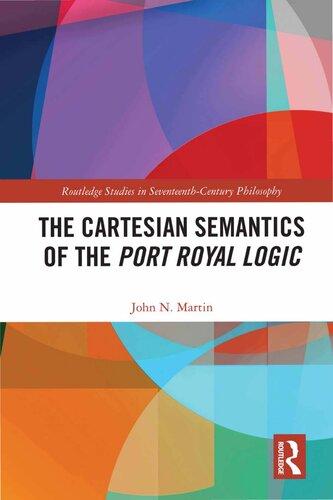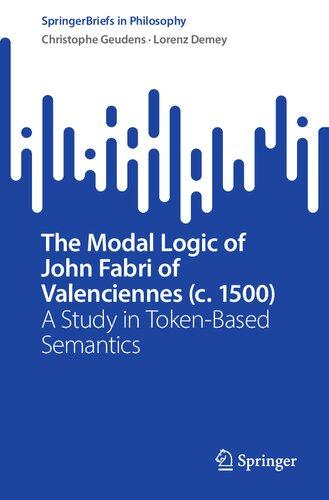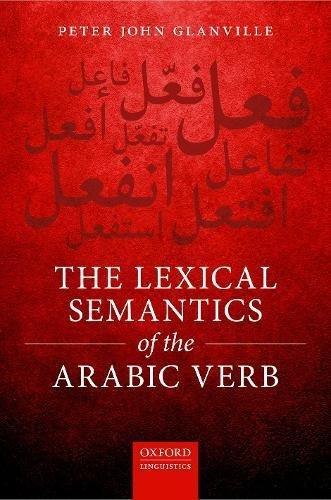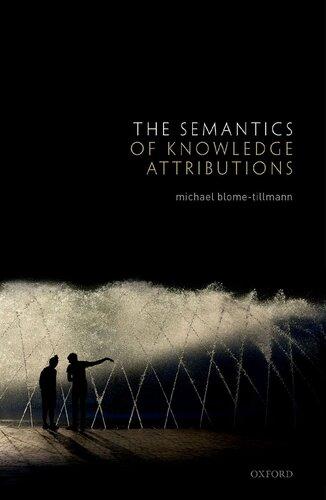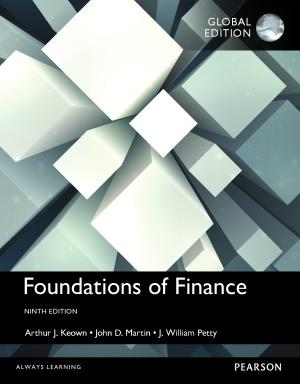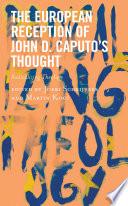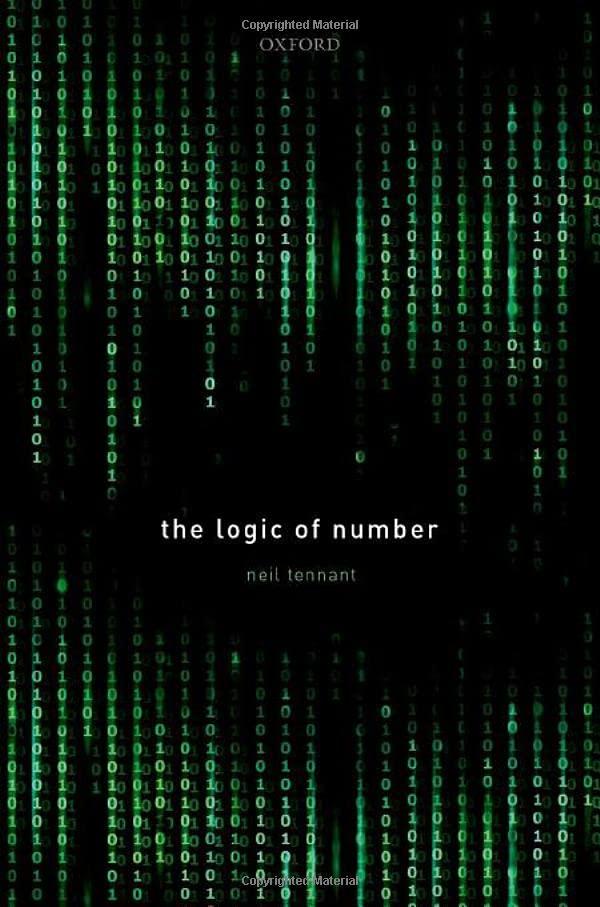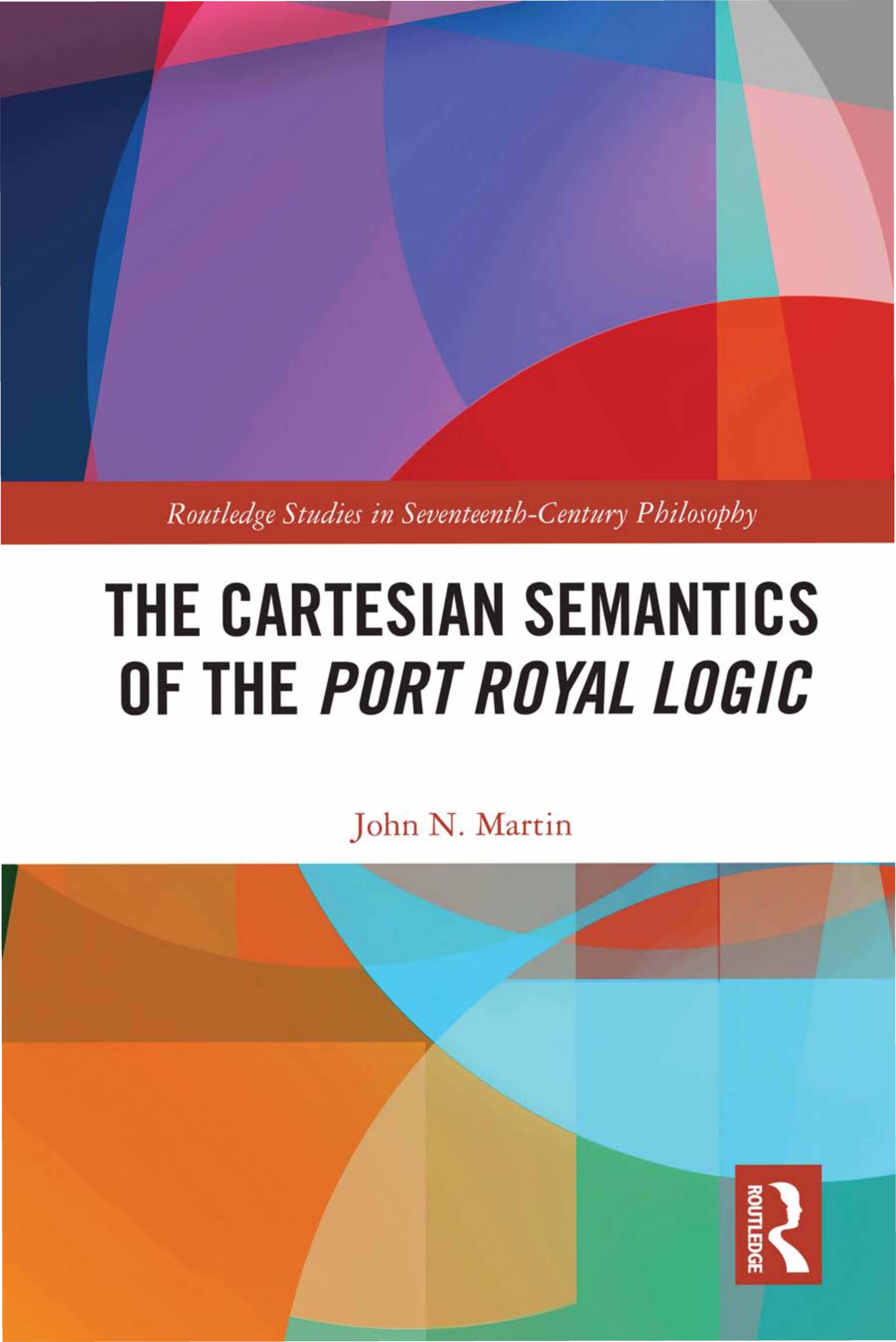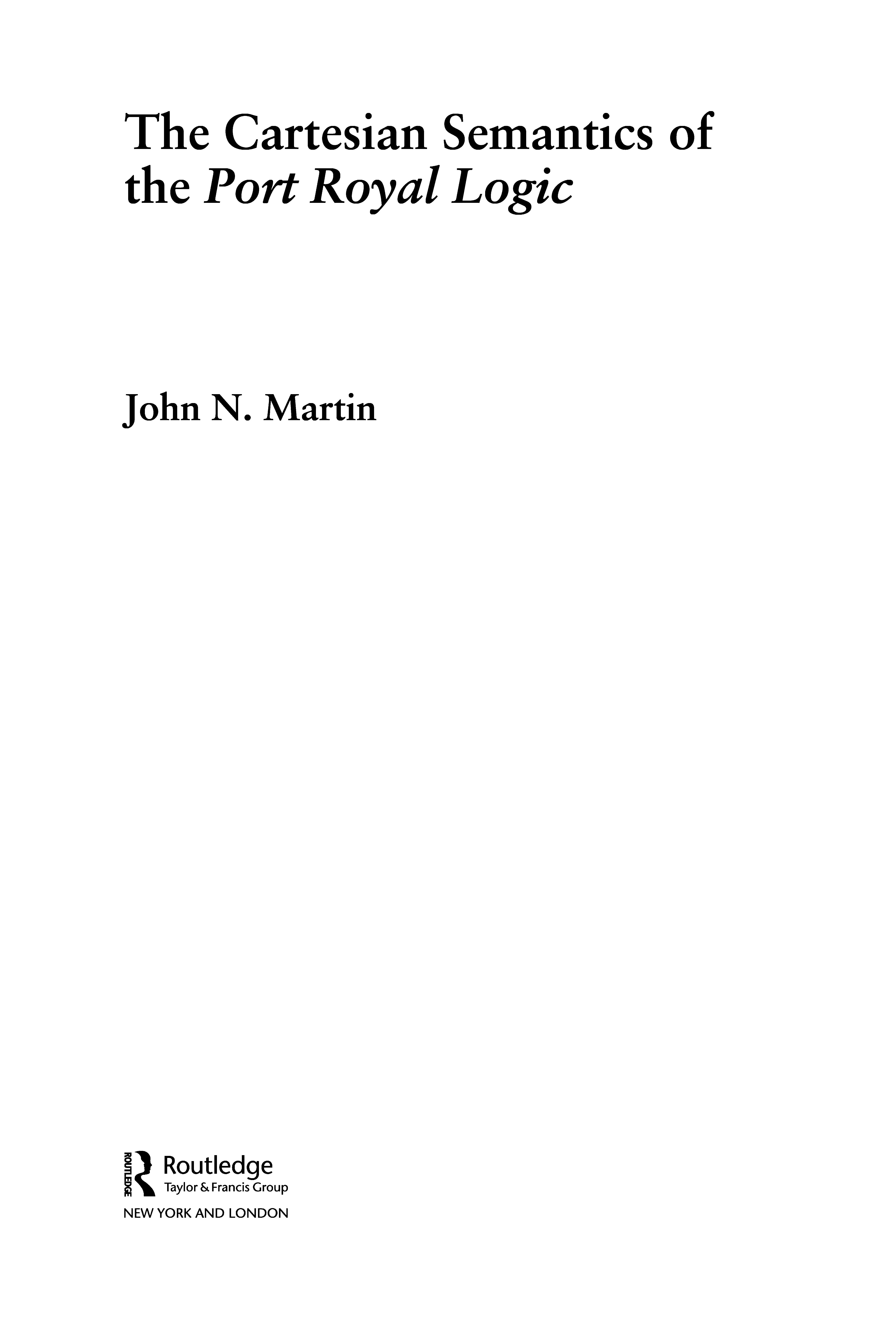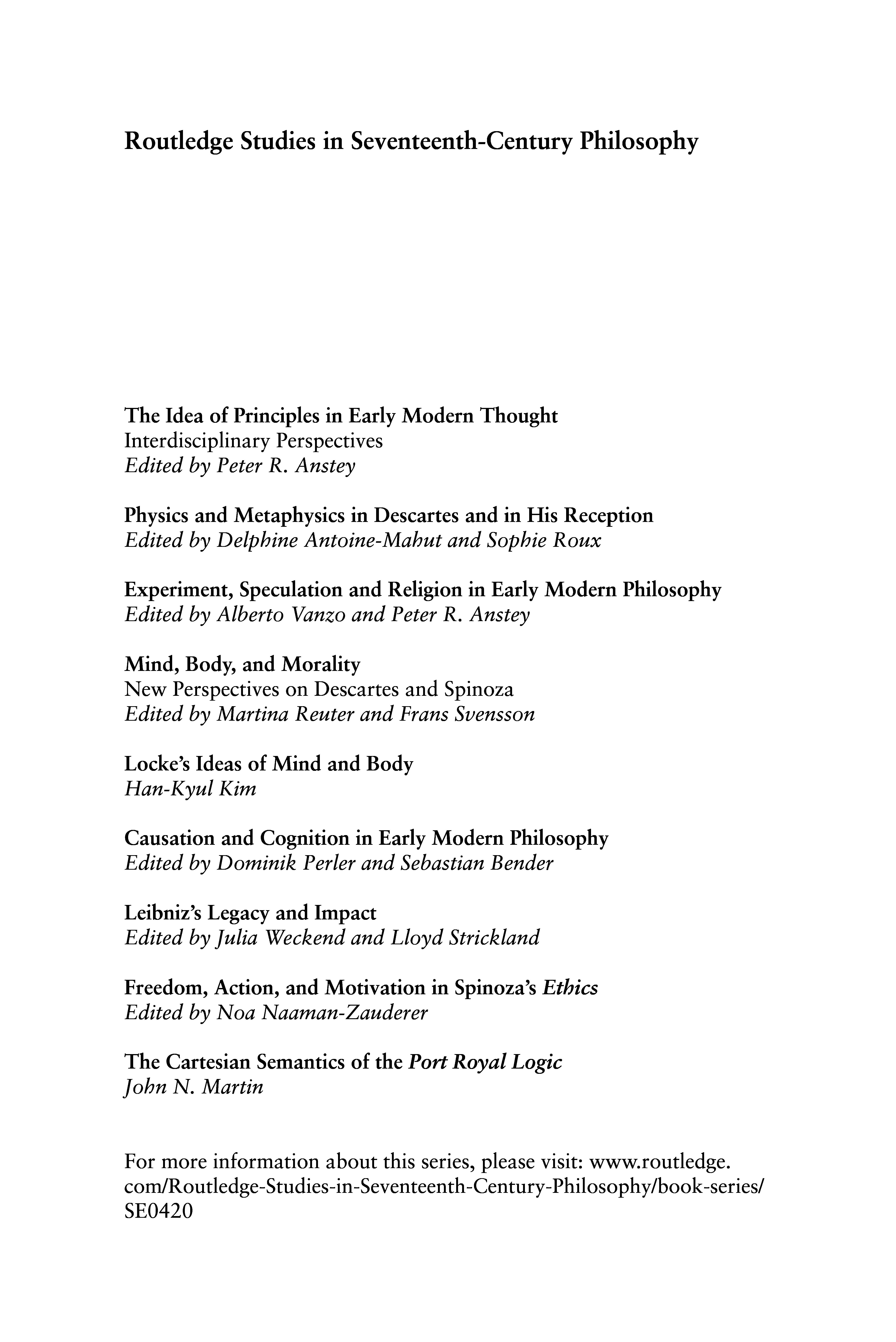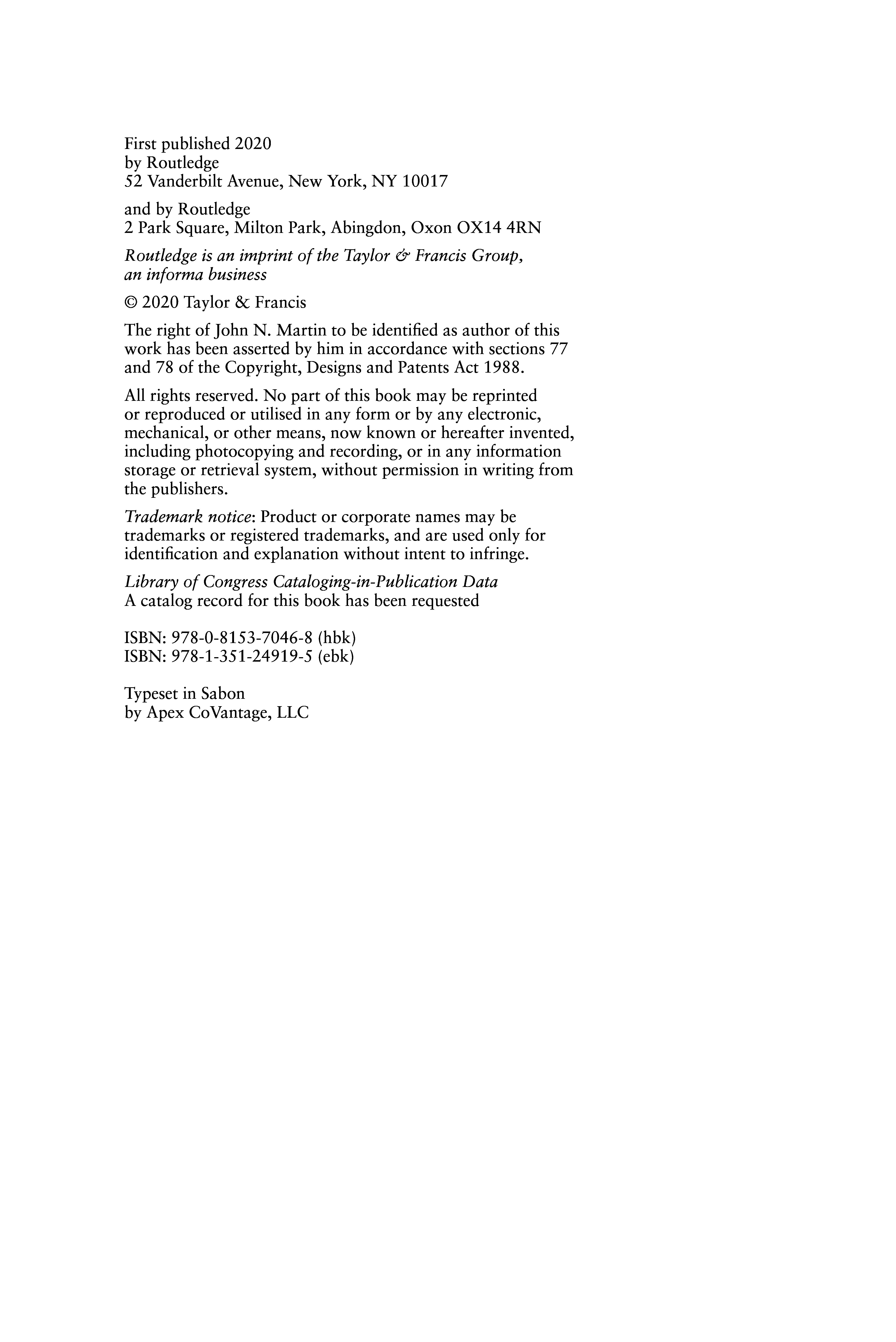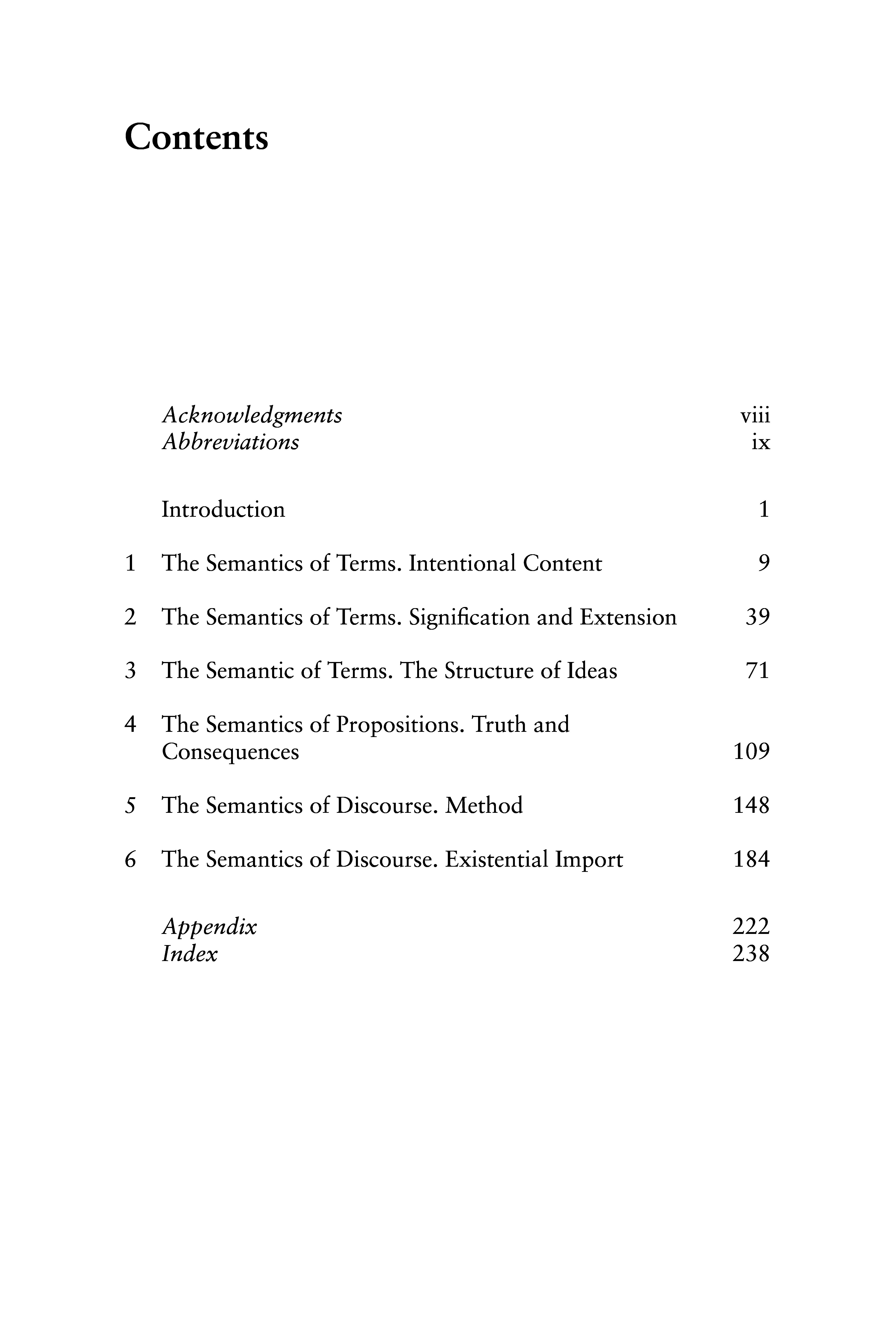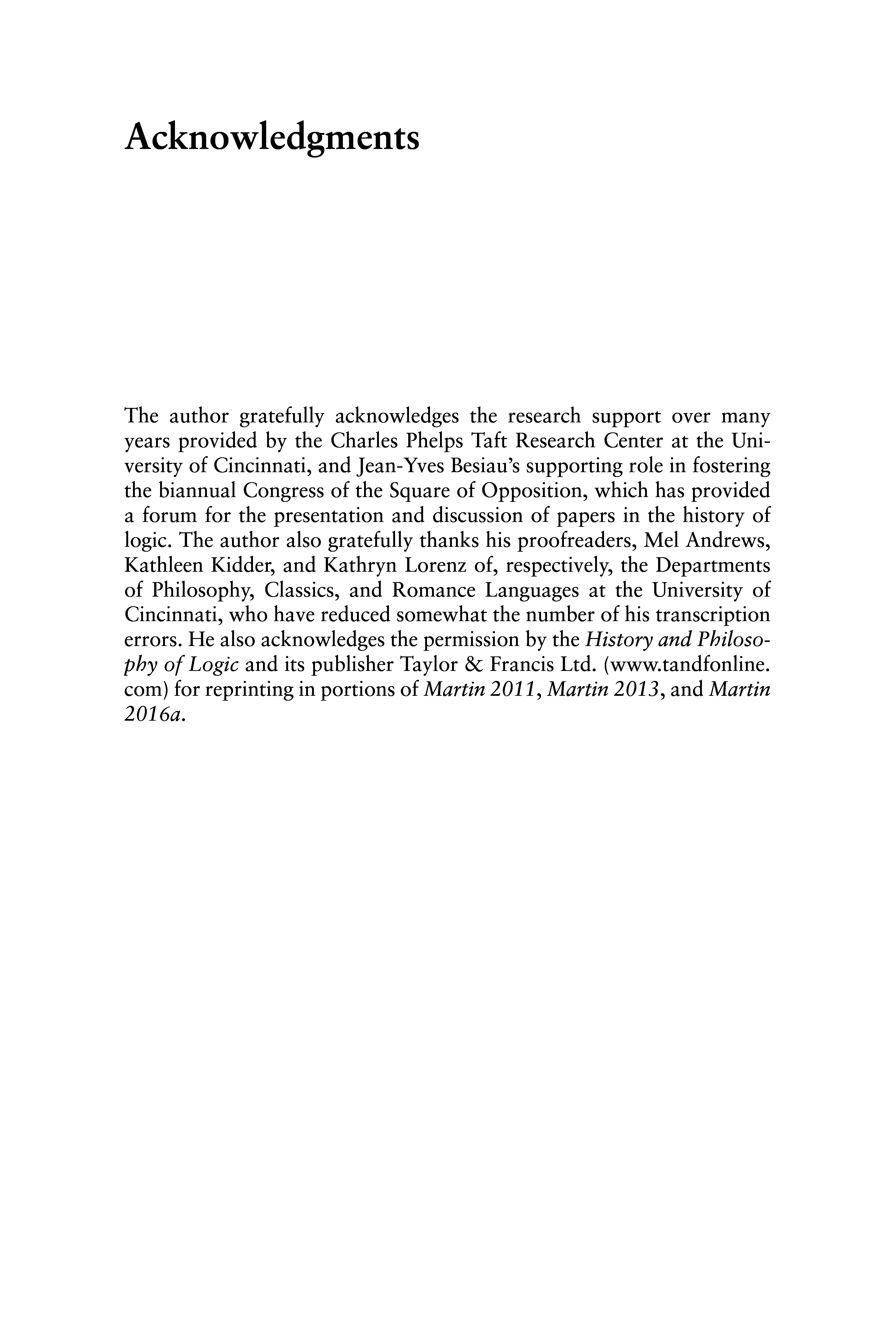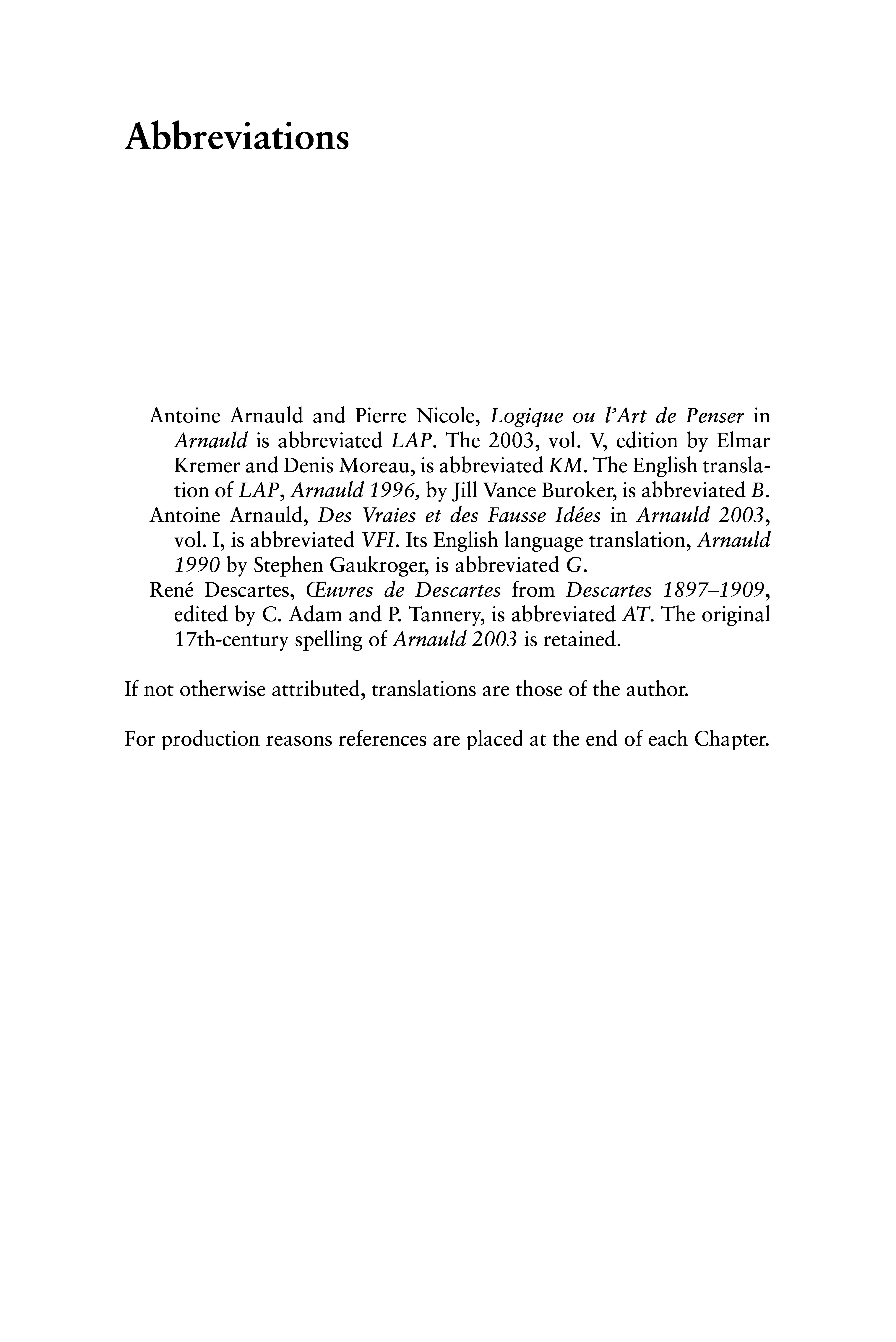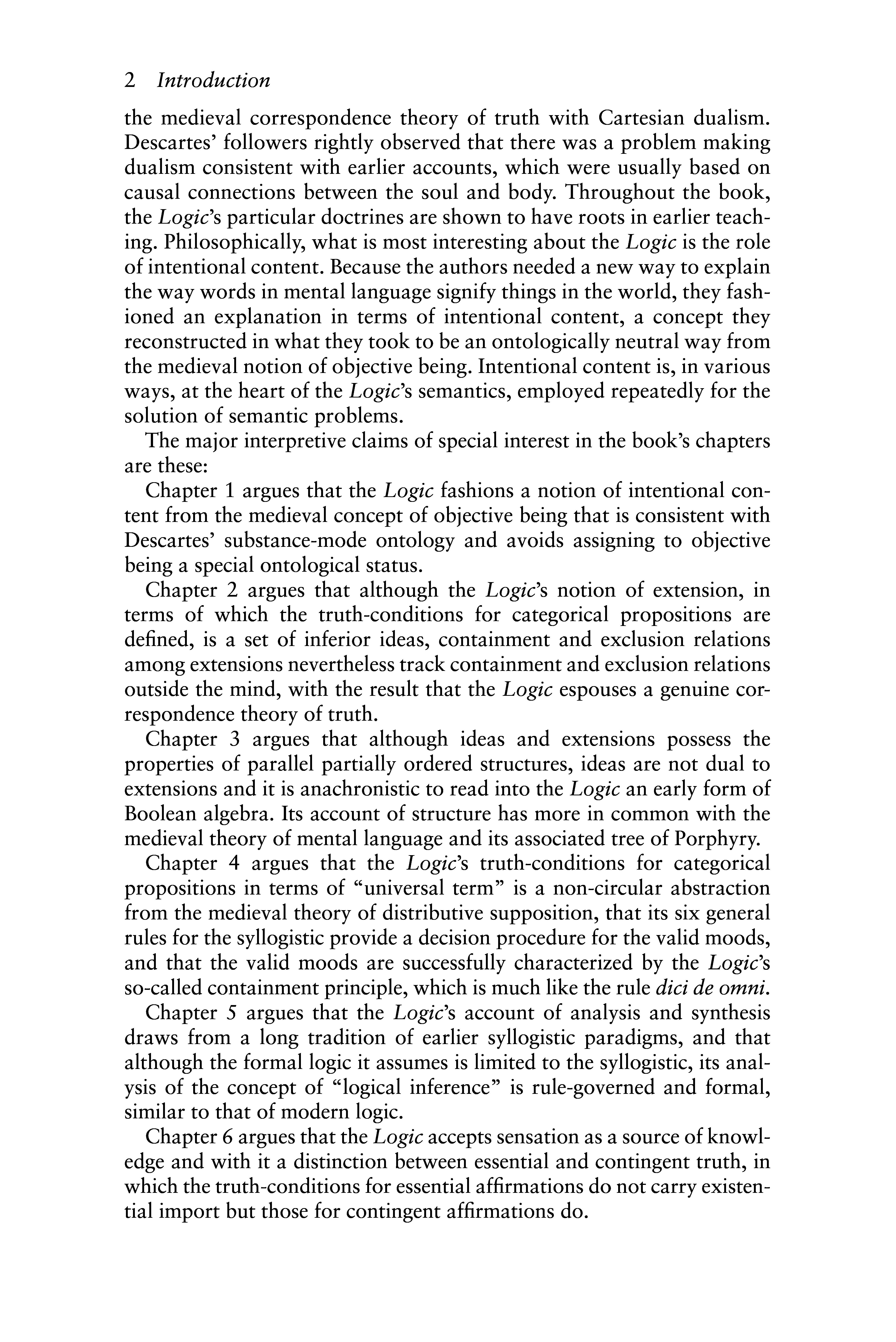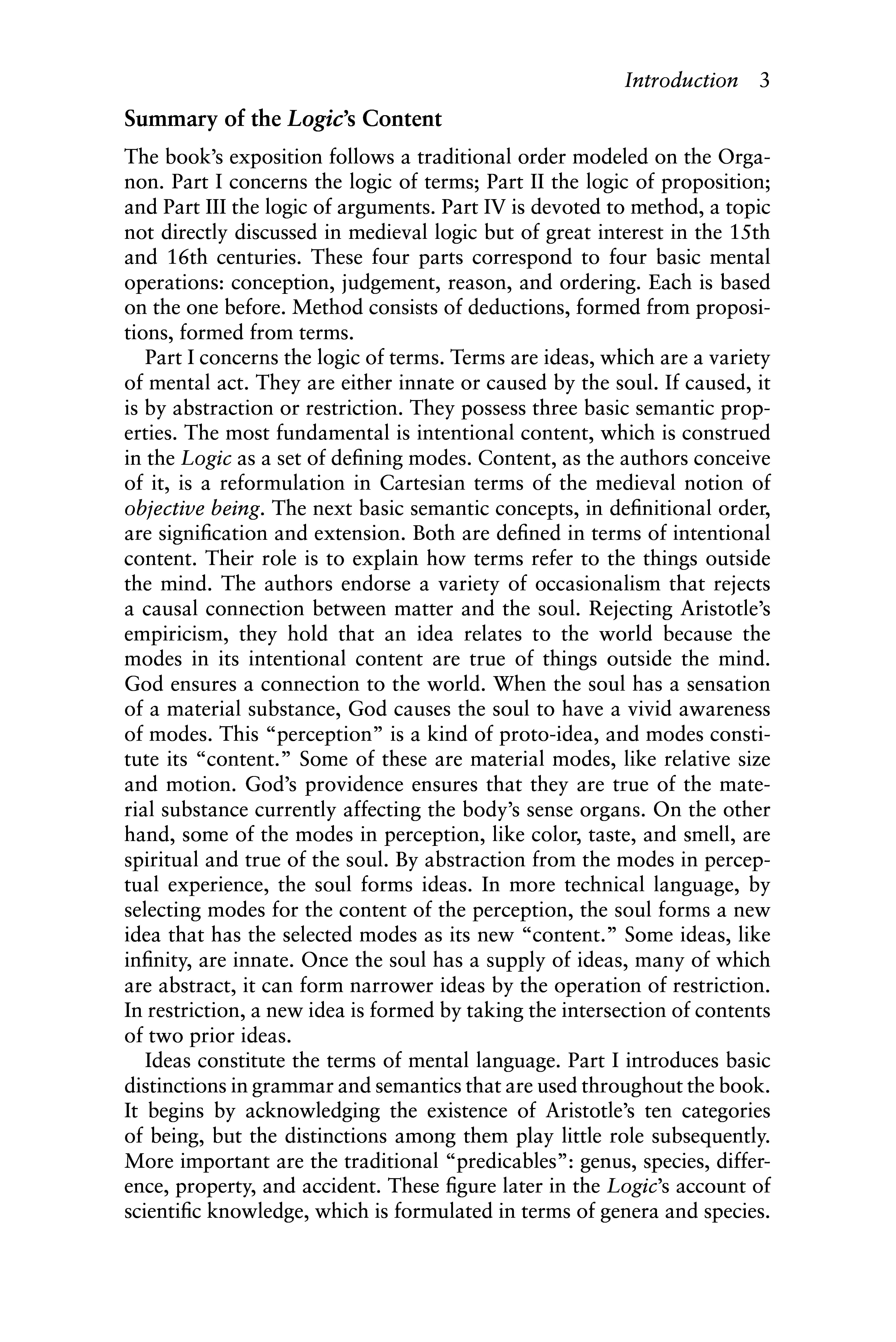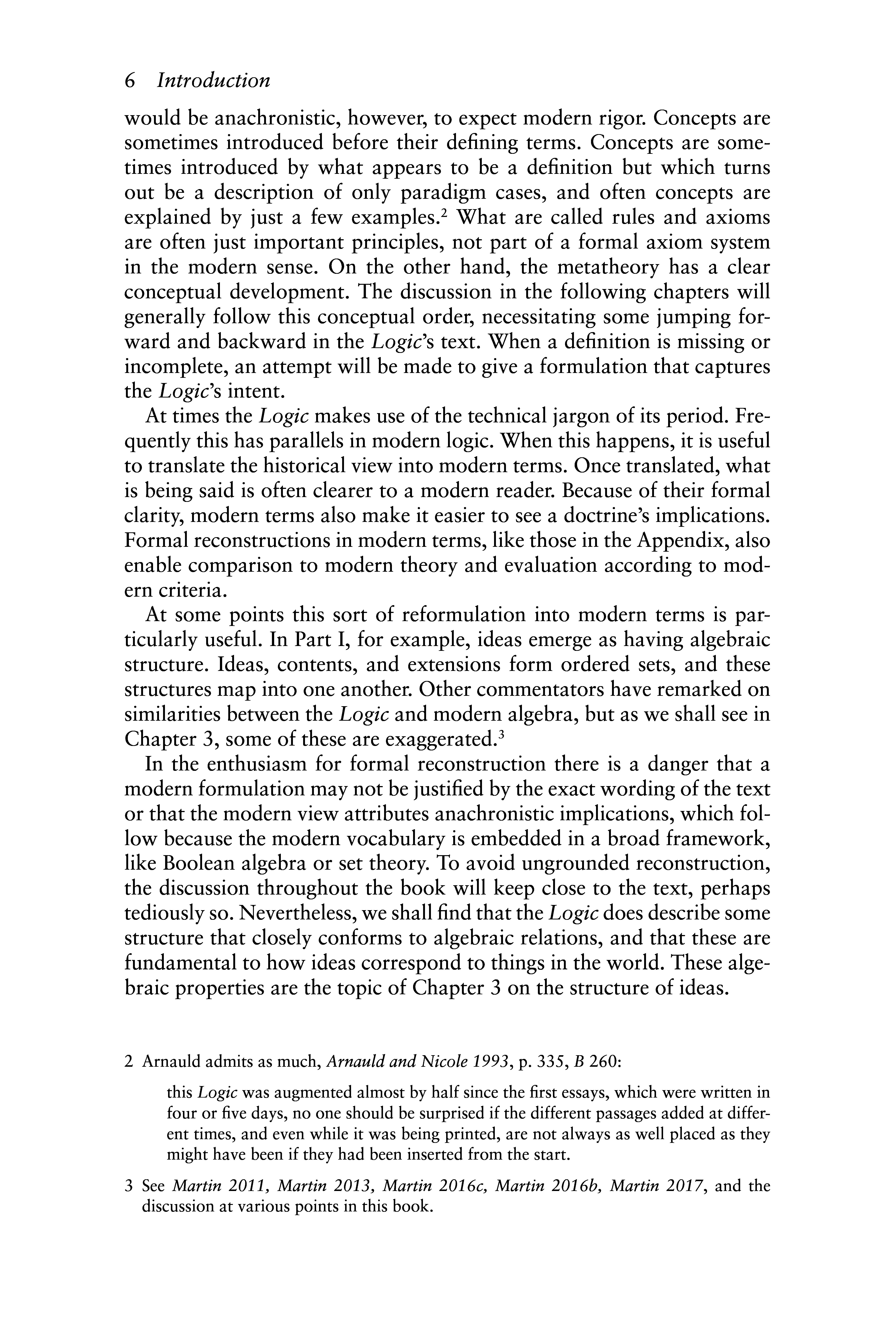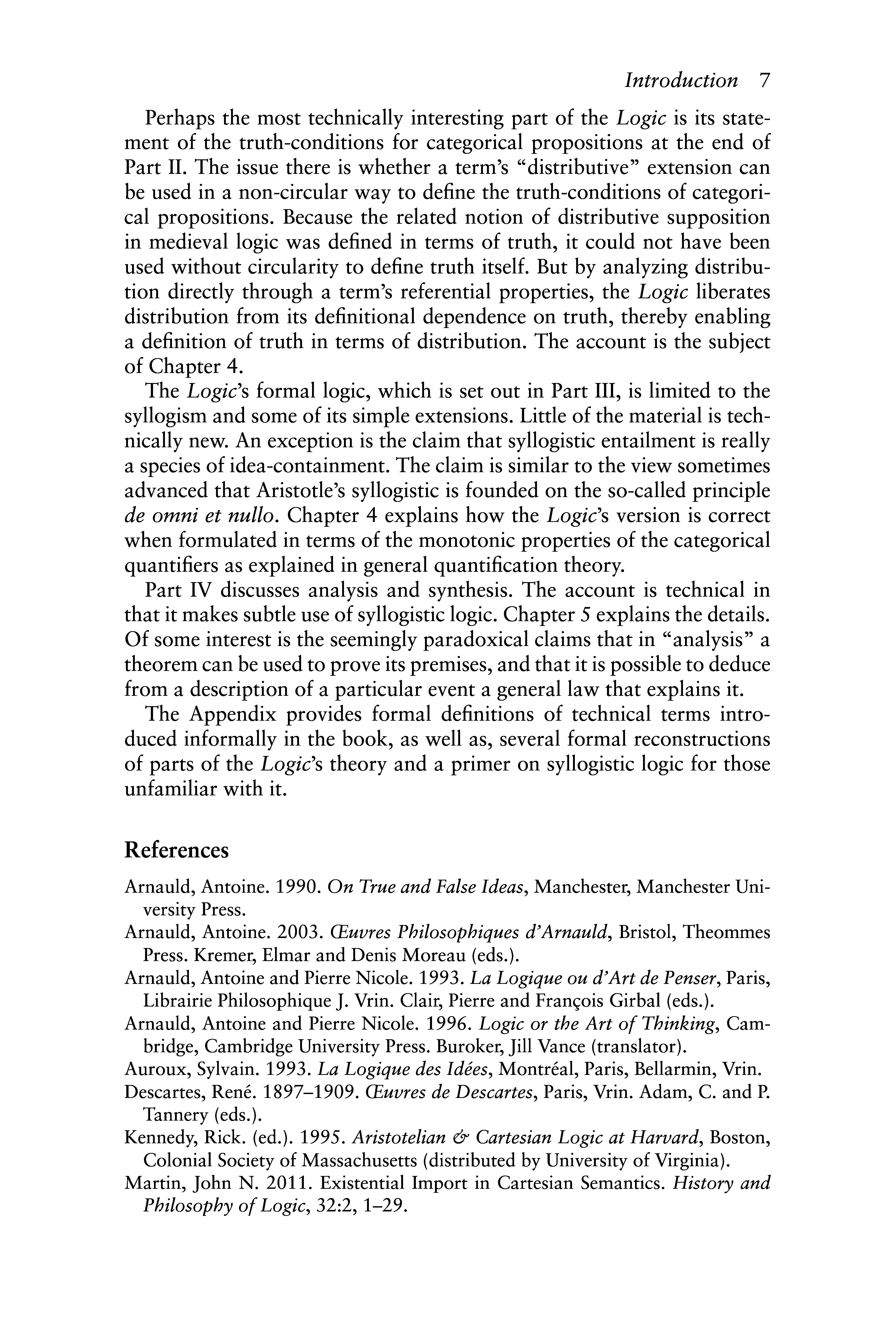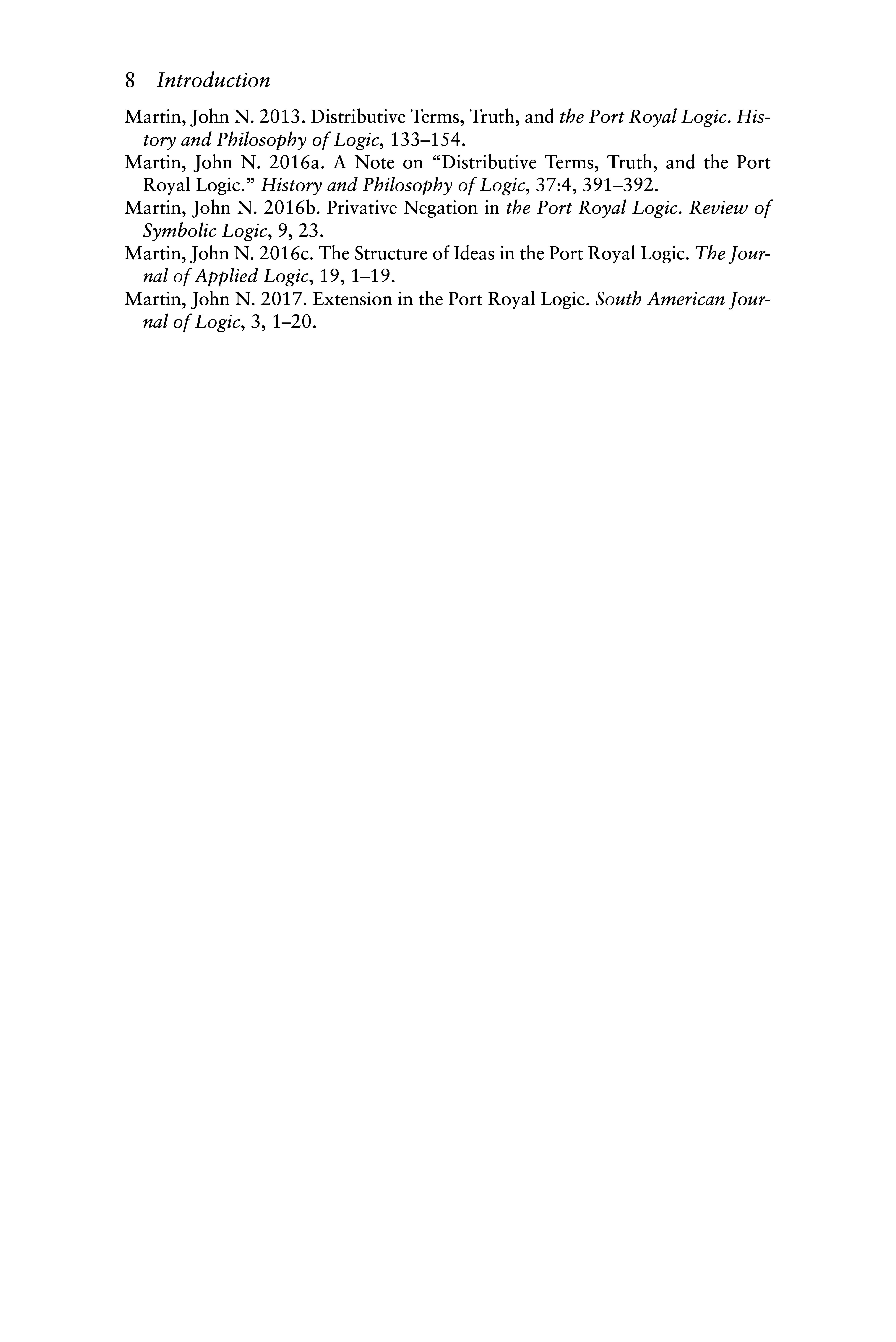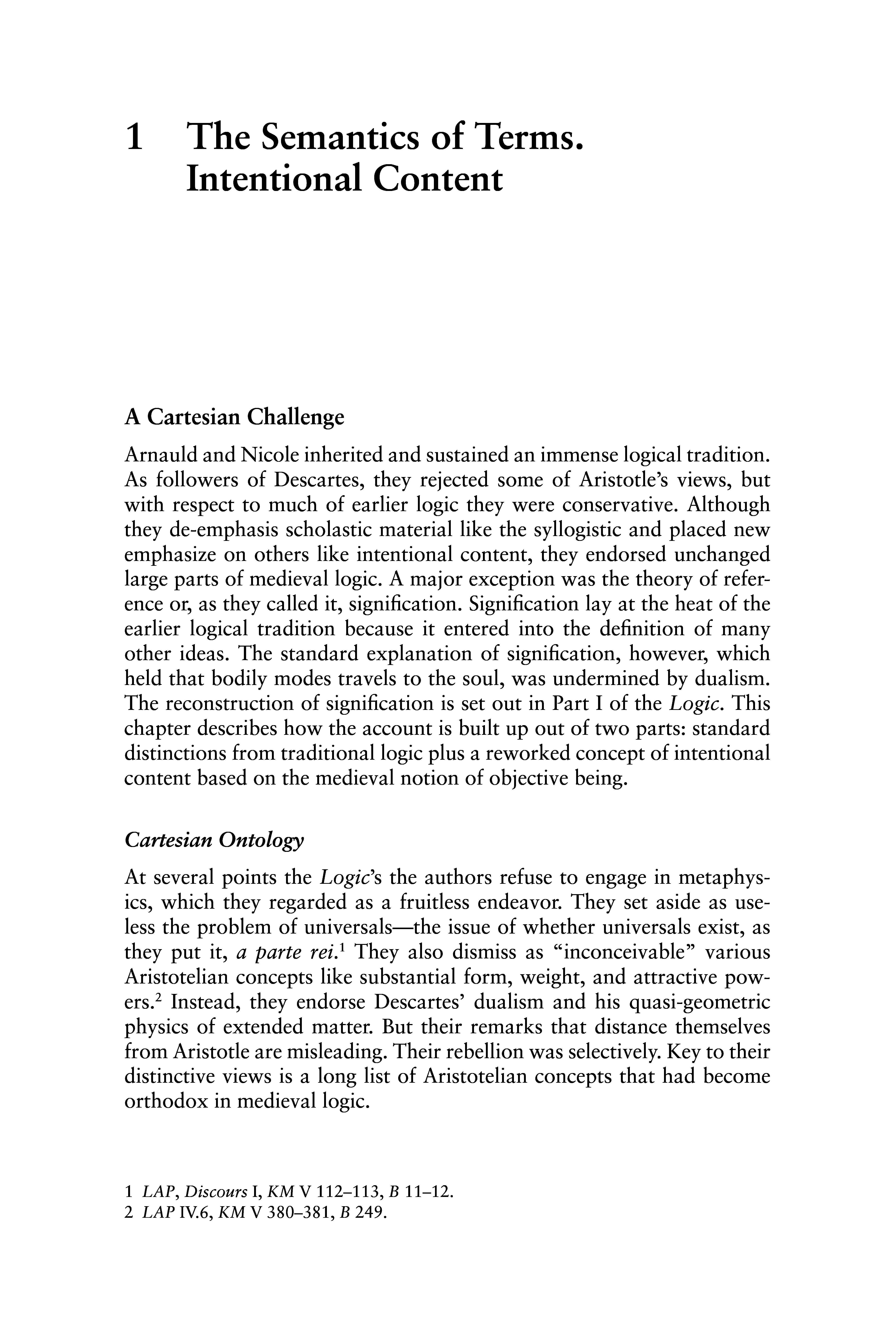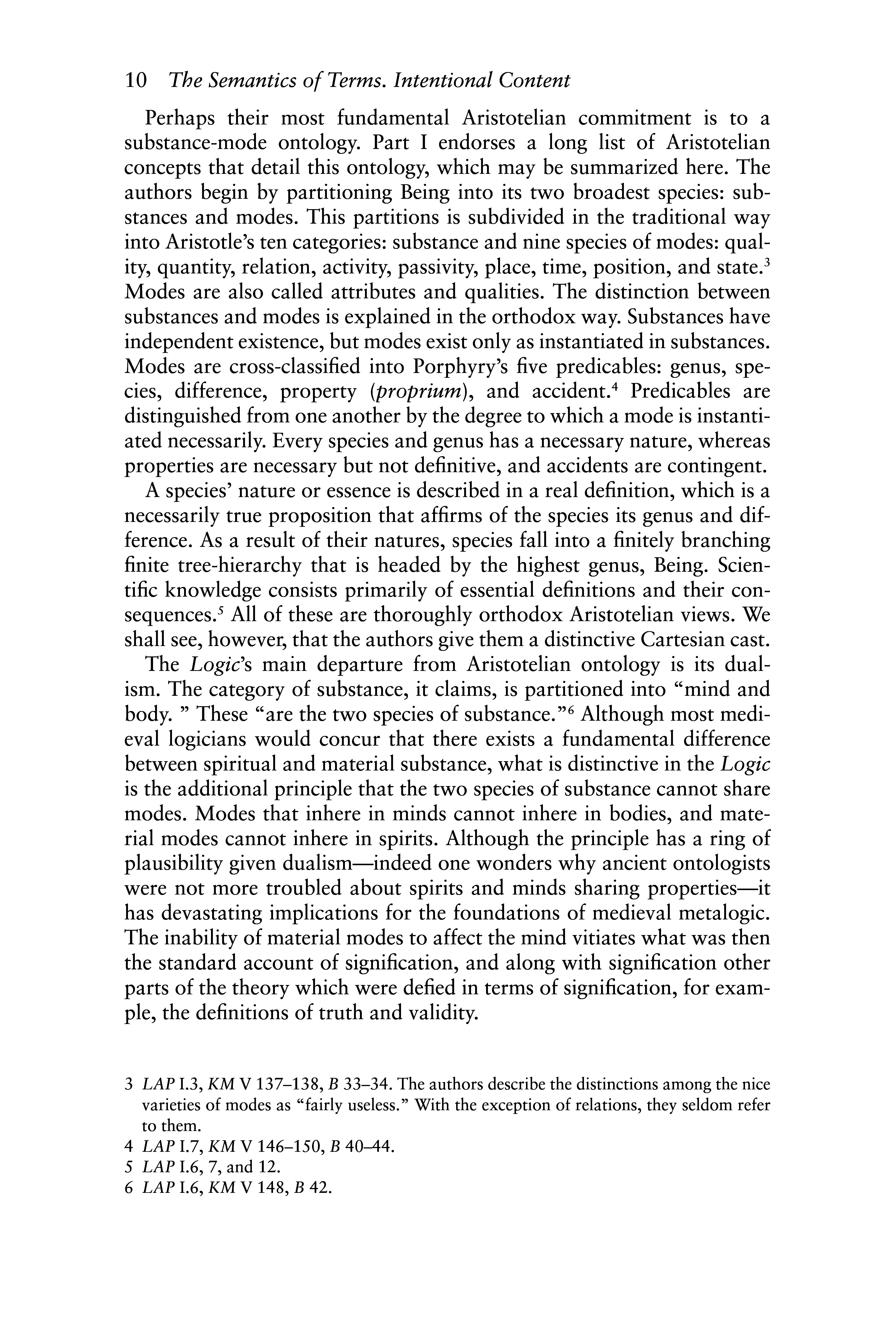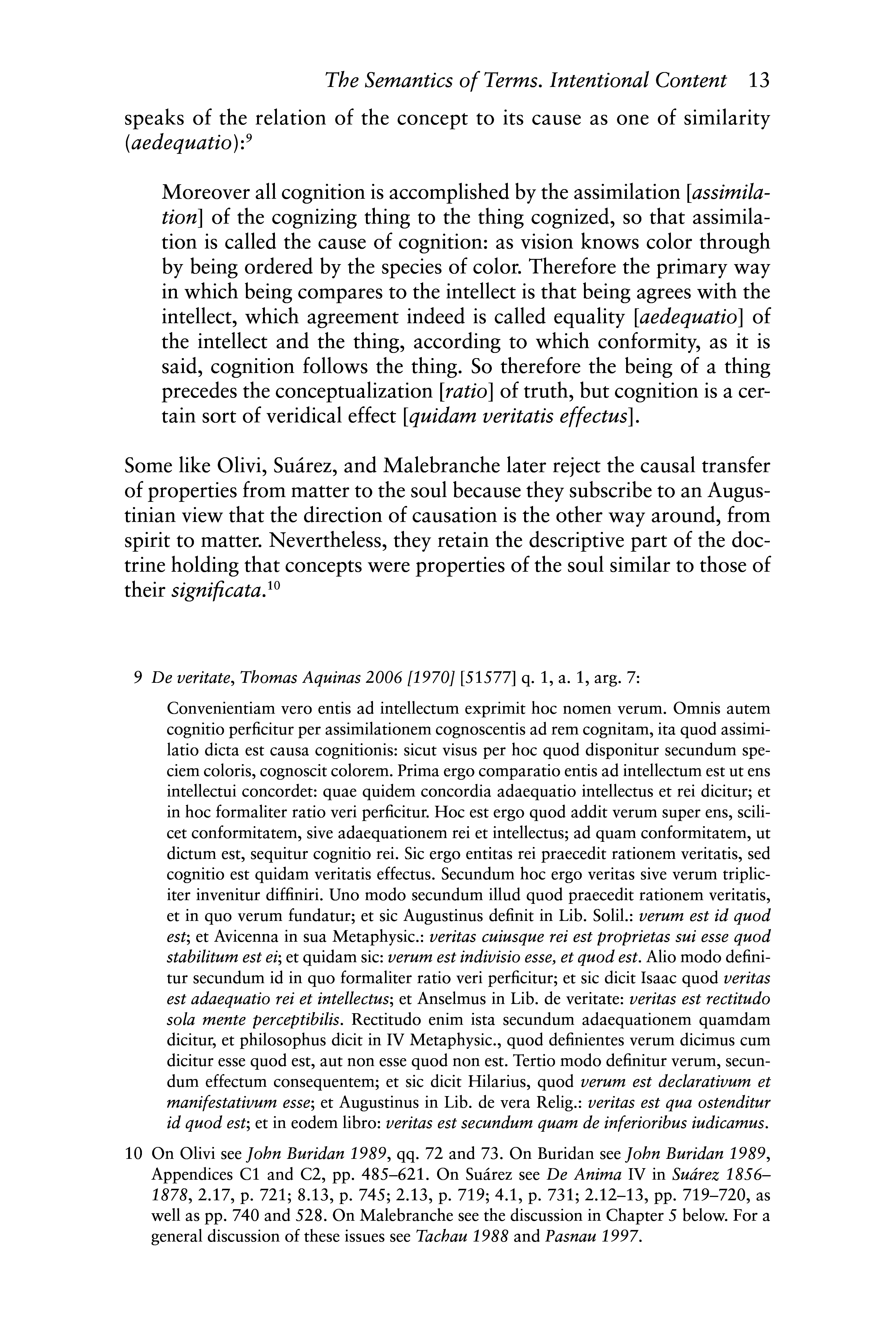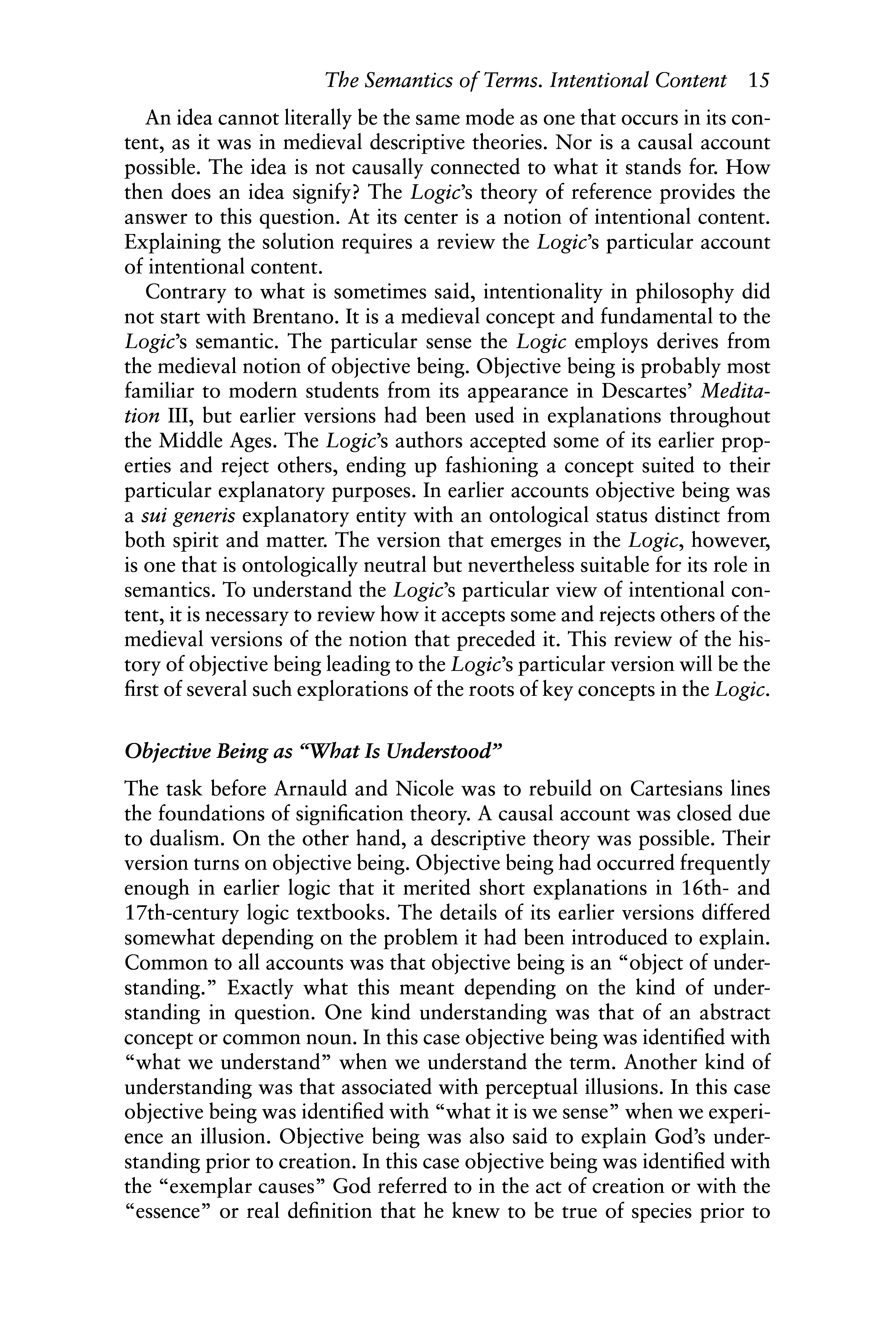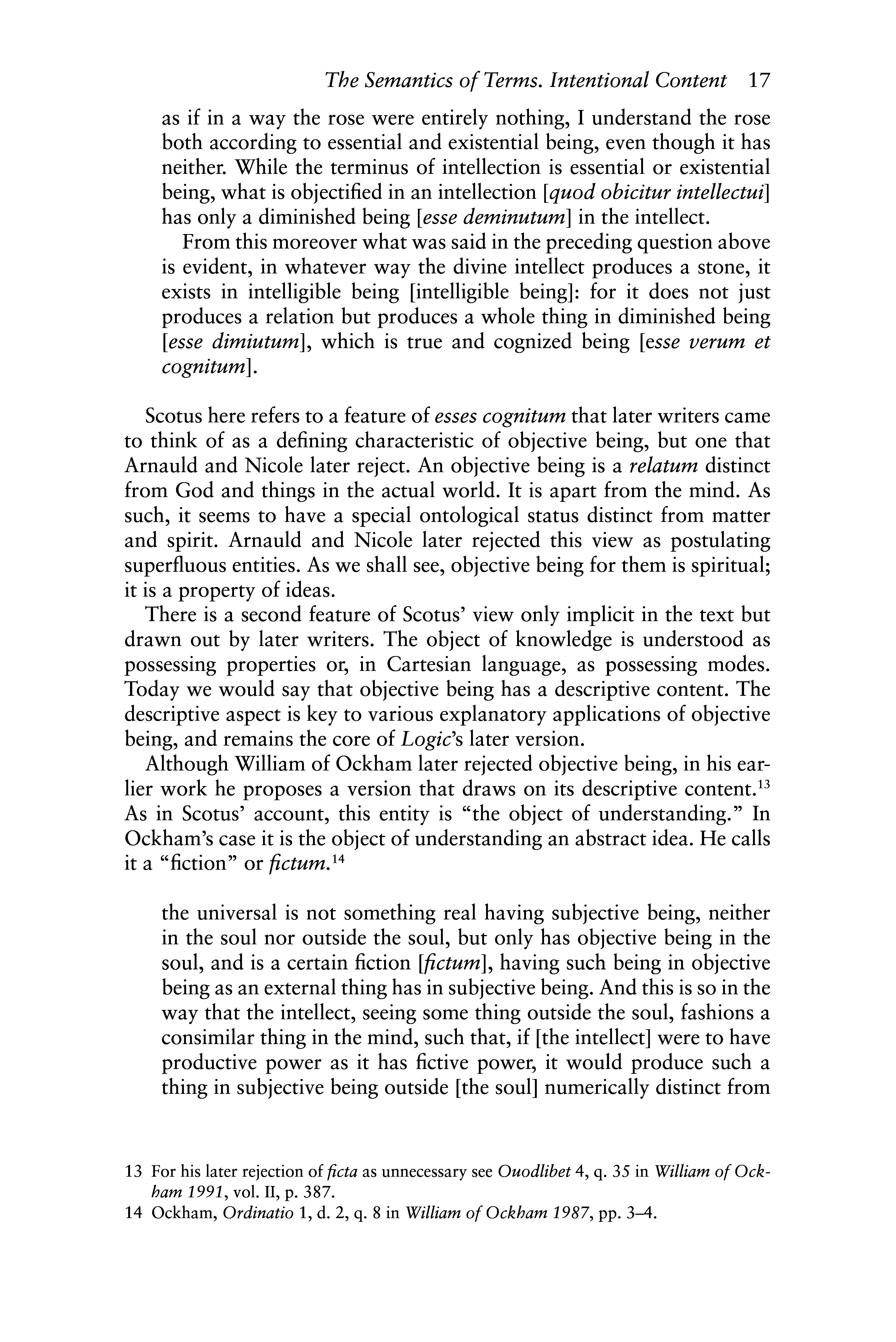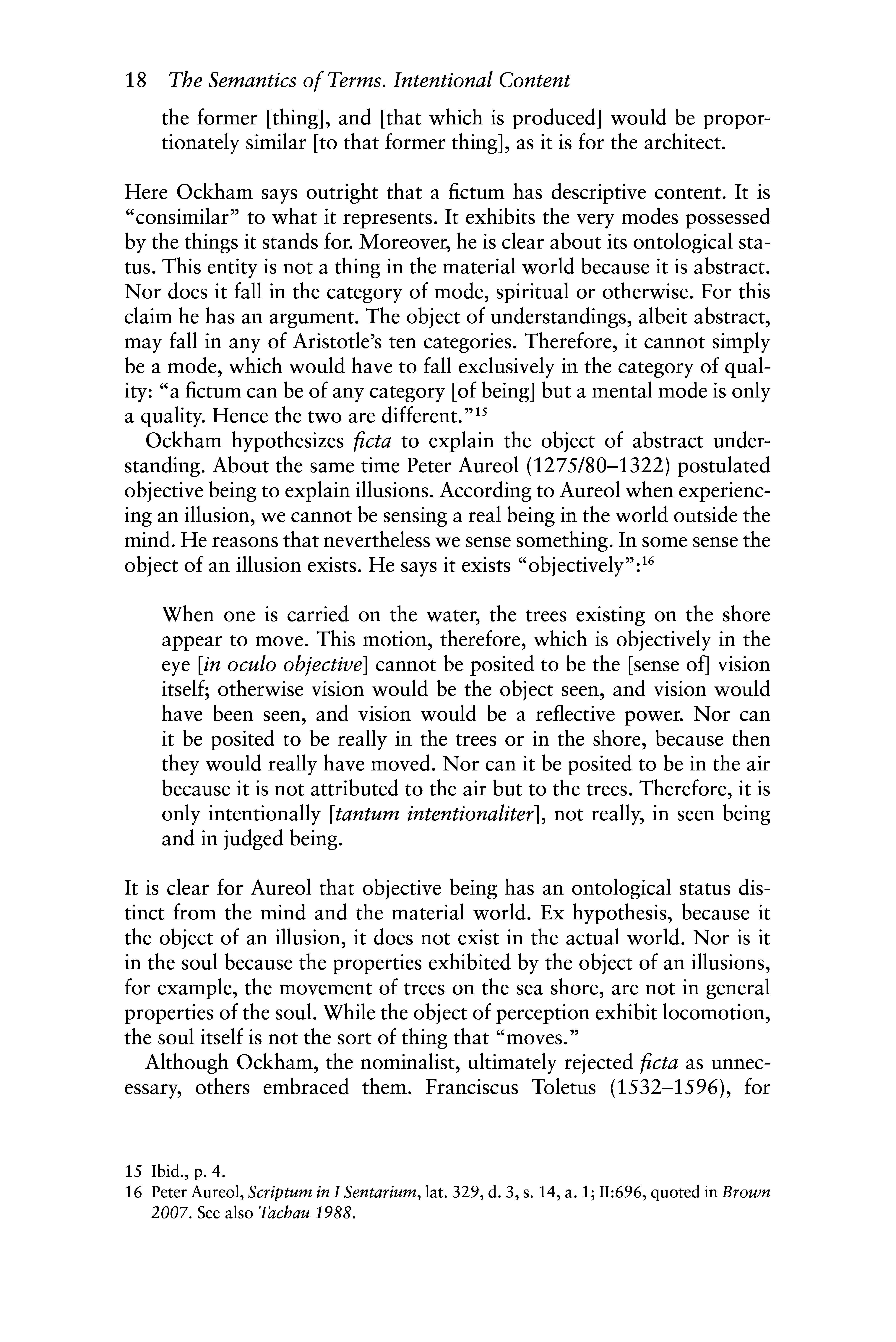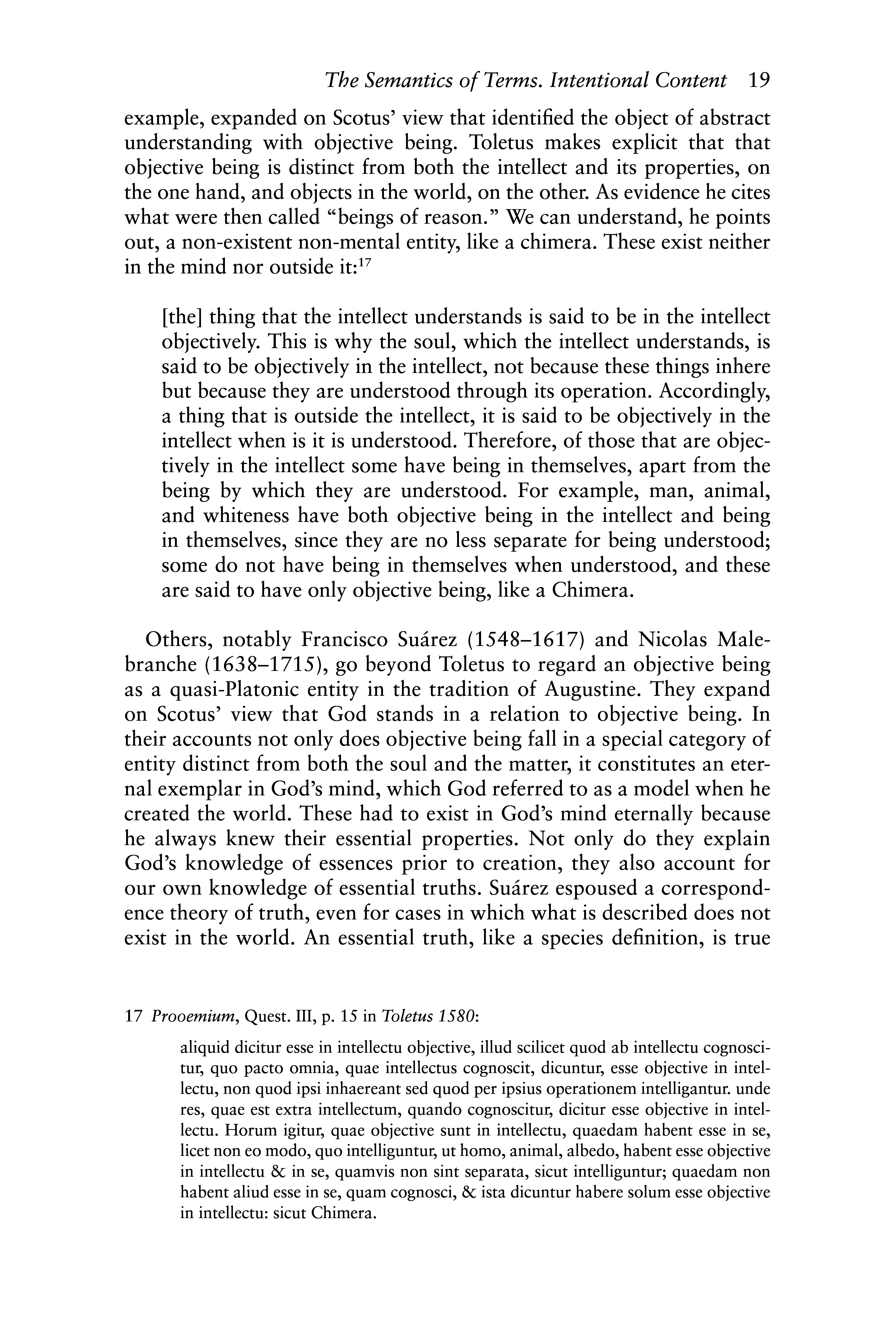The Cartesian Semantics of the Port Royal Logic
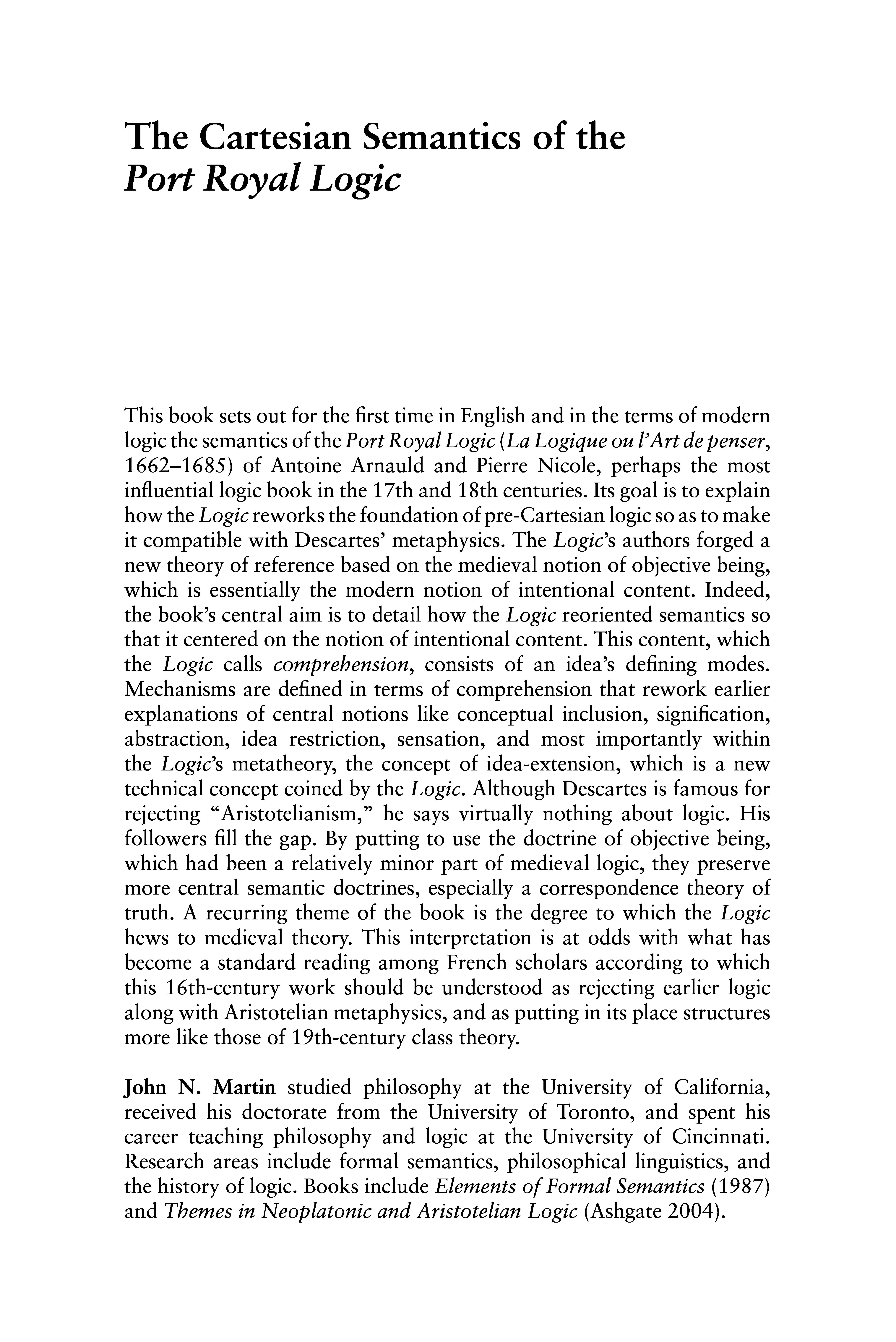
This book sets out for the first time in English and in the terms of modern logic the semantics of the Port Royal Logic (La Logique ou t' Art de penser, 1662-1685) of Antoine Arnauld and Pierre Nicole, perhaps the most influential logic book in the 17th and 18th centuries. Its goal is to explain how the Logic reworks the foundation of pre-Cartesian logic so as to make it compatible with Descartes' metaphysics. The Logic's authors forged a new theory of reference based on the medieval notion of objective being, which is essentially the modern notion of intentional content. Indeed, the book's central aim is to detail how the Logic reoriented semantics so that it centered on the notion of intentional content. This content, which the Logic calls comprehension, consists of an idea's defining modes. Mechanisms are defined in terms of comprehension that rework earlier explanations of central notions like conceptual inclusion, signification, abstraction, idea restriction, sensation, and most importantly within the Logic's metatheory, the concept of idea-extension, which is a new technical concept coined by the Logic. Although Descartes is famous for rejecting "Aristotelianism," he says virtually nothing about logic. His followers fill the gap. By putting to use the doctrine of objective being, which had been a relatively minor part of medieval logic, they preserve more central semantic doctrines, especially a correspondence theory of truth. A recurring theme of the book is the degree to which the Logic hews to medieval theory. This interpretation is at odds with what has become a standard reading among French scholars according to which this 16th-century work should be understood as rejecting earlier logic along with Aristotelian metaphysics, and as putting in its place structures more like those of 19th-century class theory.
John N. Martin studied philosophy at the University of California, received his doctorate from the University of Toronto, and spent his career teaching philosophy and logic at the University of Cincinnati. Research areas include formal semantics, philosophical linguistics, and the history of logic. Books include Elements of Formal Semantics (1987) and Themes in Neoplatonic and Aristotelian Logic (Ashgate 2004).
Routledge Studies in Seventeenth-Century Philosophy
The Idea of Principles in Early Modern Thought
Interdisciplinary Perspectives
Edited by Peter R. Anstey
Physics and Metaphysics in Descartes and in His Reception
Edited by Delphine Antoine-Mahut and Sophie Roux
Experiment, Speculation and Religion in Early Modern Philosophy
Edited by Alberto Vanzo and Peter R. Anstey
Mind, Body, and Morality
New Perspectives on Descartes and Spinoza
Edited by Martina Reuter and Frans Svensson
Locke's Ideas of Mind and Body
Han-Kyul Kim
Causation and Cognition in Early Modern Philosophy
Edited by Dominik Perler and Sebastian Bender
Leibniz's Legacy and Impact
Edited by Julia Weekend and Lloyd Strickland
Freedom, Action, and Motivation in Spinoza's Ethics
Edited by Noa Naaman-Zauderer
The Cartesian Semantics of the Port Royal Logic
John N. Martin
For more information about this series, please visit: www.routledge. com/Rou tledge-S tudies- in -Seventeenth -Century -Philosop h y/book -series/ SE0420
First published 2020 by Routledge
52 Vanderbilt Avenue, New York, NY 10017
and by Routledge
2 Park Square, Milton Park, Abingdon, Oxon OX14 4RN
Routledge is an imprint of the Taylor & Francis an informa business
© 2020 Taylor & Francis
The right of John N. Martin to be identified as author of this work has been asserted by him in accordance with sections 77 and 78 of the Copyright, Designs and Patents Act 1988.
All rights reserved. No part of this book may be reprinted or reproduced or utilised in any form or by any electronic, mechanical, or other means, now known or hereafter invented, including photocopying and recording, or in any information storage or retrieval system, without permission in writing from the publishers.
Trademark notice: Product or corporate names may be trademarks or registered trademarks, and are used only for identification and explanation without intent to infringe.
Library of Congress Cataloging-in-Publication Data
A catalog record for this book has been requested
ISBN: 978-0-8153-7046-8 (hbk)
ISBN: 978-1-351-24919-5 (ebk)
Typeset in Sabon by Apex CoVantage, LLC
For Jane and Neil
Taylor & Francis
Taylor & Franc.is Group
http://taylorandfrands.com
Introduction
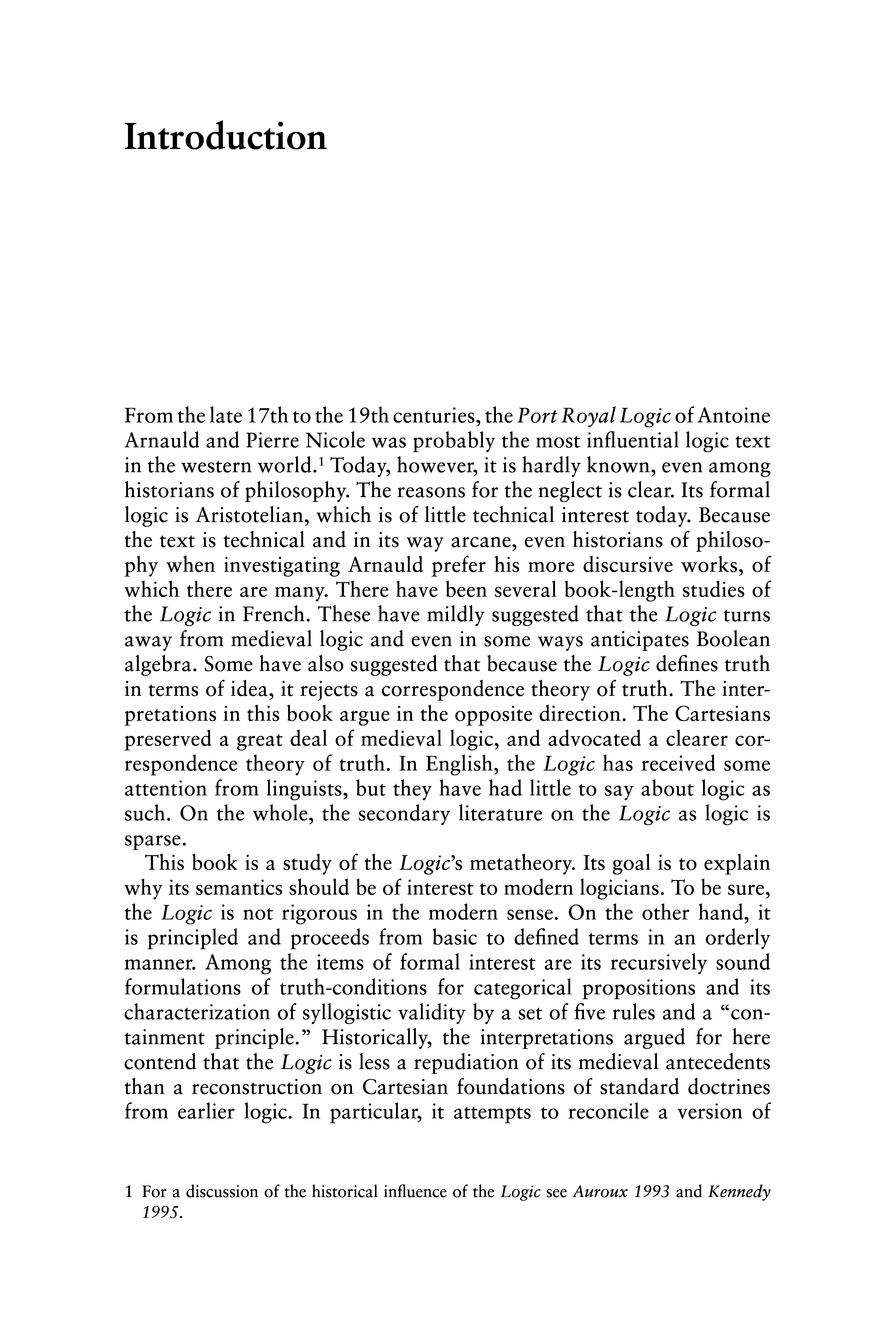
From the late 17th to the 19th centuries, the Port Royal Logic of Antoine Arnauld and Pierre Nicole was probably the most influential logic text in the western world. 1 Today, however, it is hardly known, even among historians of philosophy. The reasons for the neglect is clear. Its formal logic is Aristotelian, which is of little technical interest today. Because the text is technical and in its way arcane, even historians of philosophy when investigating Arnauld prefer his more discursive works, of which there are many. There have been several book-length studies of the Logic in French. These have mildly suggested that the Logic turns away from medieval logic and even in some ways anticipates Boolean algebra. Some have also suggested that because the Logic defines truth in terms of idea, it rejects a correspondence theory of truth. The interpretations in this book argue in the opposite direction. The Cartesians preserved a great deal of medieval logic, and advocated a clearer correspondence theory of truth. In English, the Logic has received some attention from linguists, but they have had little to say about logic as such. On the whole, the secondary literature on the Logic as logic is sparse.
This book is a study of the Logic's metatheory. Its goal is to explain why its semantics should be of interest to modern logicians. To be sure, the Logic is not rigorous in the modern sense. On the other hand, it is principled and proceeds from basic to defined terms in an orderly manner. Among the items of formal interest are its recursively sound formulations of truth-conditions for categorical propositions and its characterization of syllogistic validity by a set of five rules and a "containment principle." Historically, the interpretations argued for here contend that the Logic is less a repudiation of its medieval antecedents than a reconstruction on Cartesian foundations of standard doctrines from earlier logic. In particular, it attempts to reconcile a version of
1 For a discussion of the historical influence of the Logic see Auroux 1993 and Kennedy 1995.
the medieval correspondence theory of truth with Cartesian dualism. Descartes' followers rightly observed that there was a problem making dualism consistent with earlier accounts, which were usually based on causal connections between the soul and body. Throughout the book, the Logic's particular doctrines are shown to have roots in earlier teaching. Philosophically, what is most interesting about the Logic is the role of intentional content. Because the authors needed a new way to explain the way words in mental language signify things in the world, they fashioned an explanation in terms of intentional content, a concept they reconstructed in what they took to be an ontologically neutral way from the medieval notion of objective being. Intentional content is, in various ways, at the heart of the Logic's semantics, employed repeatedly for the solution of semantic problems.
The major interpretive claims of special interest in the book's chapters are these:
Chapter 1 argues that the Logic fashions a notion of intentional content from the medieval concept of objective being that is consistent with Descartes' substance-mode ontology and avoids assigning to objective being a special ontological status.
Chapter 2 argues that although the Logic's notion of extension, in terms of which the truth-conditions for categorical propositions are defined, is a set of inferior ideas, containment and exclusion relations among extensions nevertheless track containment and exclusion relations outside the mind, with the result that the Logic espouses a genuine correspondence theory of truth.
Chapter 3 argues that although ideas and extensions possess the properties of parallel partially ordered structures, ideas are not dual to extensions and it is anachronistic to read into the Logic an early form of Boolean algebra. Its account of structure has more in common with the medieval theory of mental language and its associated tree of Porphyry.
Chapter 4 argues that the Logic's truth-conditions for categorical propositions in terms of "universal term" is a non-circular abstraction from the medieval theory of distributive supposition, that its six general rules for the syllogistic provide a decision procedure for the valid moods, and that the valid moods are successfully characterized by the Logic's so-called containment principle, which is much like the rule dici de omni.
Chapter 5 argues that the Logic's account of analysis and synthesis draws from a long tradition of earlier syllogistic paradigms, and that although the formal logic it assumes is limited to the syllogistic, its analysis of the concept of "logical inference" is rule-governed and formal, similar to that of modern logic.
Chapter 6 argues that the Logic accepts sensation as a source of knowledge and with it a distinction between essential and contingent truth, in which the truth-conditions for essential affirmations do not carry existential import but those for contingent affirmations do.
Summary of the Logic's Content
The book's exposition follows a traditional order modeled on the Organon. Part I concerns the logic of terms; Part II the logic of proposition; and Part III the logic of arguments. Part IV is devoted to method, a topic not directly discussed in medieval logic but of great interest in the 15th and 16th centuries. These four parts correspond to four basic mental operations: conception, judgement, reason, and ordering. Each is based on the one before. Method consists of deductions, formed from propositions, formed from terms.
Part I concerns the logic of terms. Terms are ideas, which are a variety of mental act. They are either innate or caused by the soul. If caused, it is by abstraction or restriction. They possess three basic semantic properties. The most fundamental is intentional content, which is construed in the Logic as a set of defining modes. Content, as the authors conceive of it, is a reformulation in Cartesian terms of the medieval notion of objective being. The next basic semantic concepts, in definitional order, are signification and extension. Both are defined in terms of intentional content. Their role is to explain how terms refer to the things outside the mind. The authors endorse a variety of occasionalism that rejects a causal connection between matter and the soul. Rejecting Aristotle's empiricism, they hold that an idea relates to the world because the modes in its intentional content are true of things outside the mind. God ensures a connection to the world. When the soul has a sensation of a material substance, God causes the soul to have a vivid awareness of modes. This "perception" is a kind of proto-idea, and modes constitute its "content." Some of these are material modes, like relative size and motion. God's providence ensures that they are true of the material substance currently affecting the body's sense organs. On the other hand, some of the modes in perception, like color, taste, and smell, are spiritual and true of the soul. By abstraction from the modes in perceptual experience, the soul forms ideas. In more technical language, by selecting modes for the content of the perception, the soul forms a new idea that has the selected modes as its new "content." Some ideas, like infinity, are innate. Once the soul has a supply of ideas, many of which are abstract, it can form narrower ideas by the operation of restriction. In restriction, a new idea is formed by taking the intersection of contents of two prior ideas.
Ideas constitute the terms of mental language. Part I introduces basic distinctions in grammar and semantics that are used throughout the book. It begins by acknowledging the existence of Aristotle's ten categories of being, but the distinctions among them play little role subsequently. More important are the traditional "predicables": genus, species, difference, property, and accident. These figure later in the Logic's account of scientific knowledge, which is formulated in terms of genera and species.
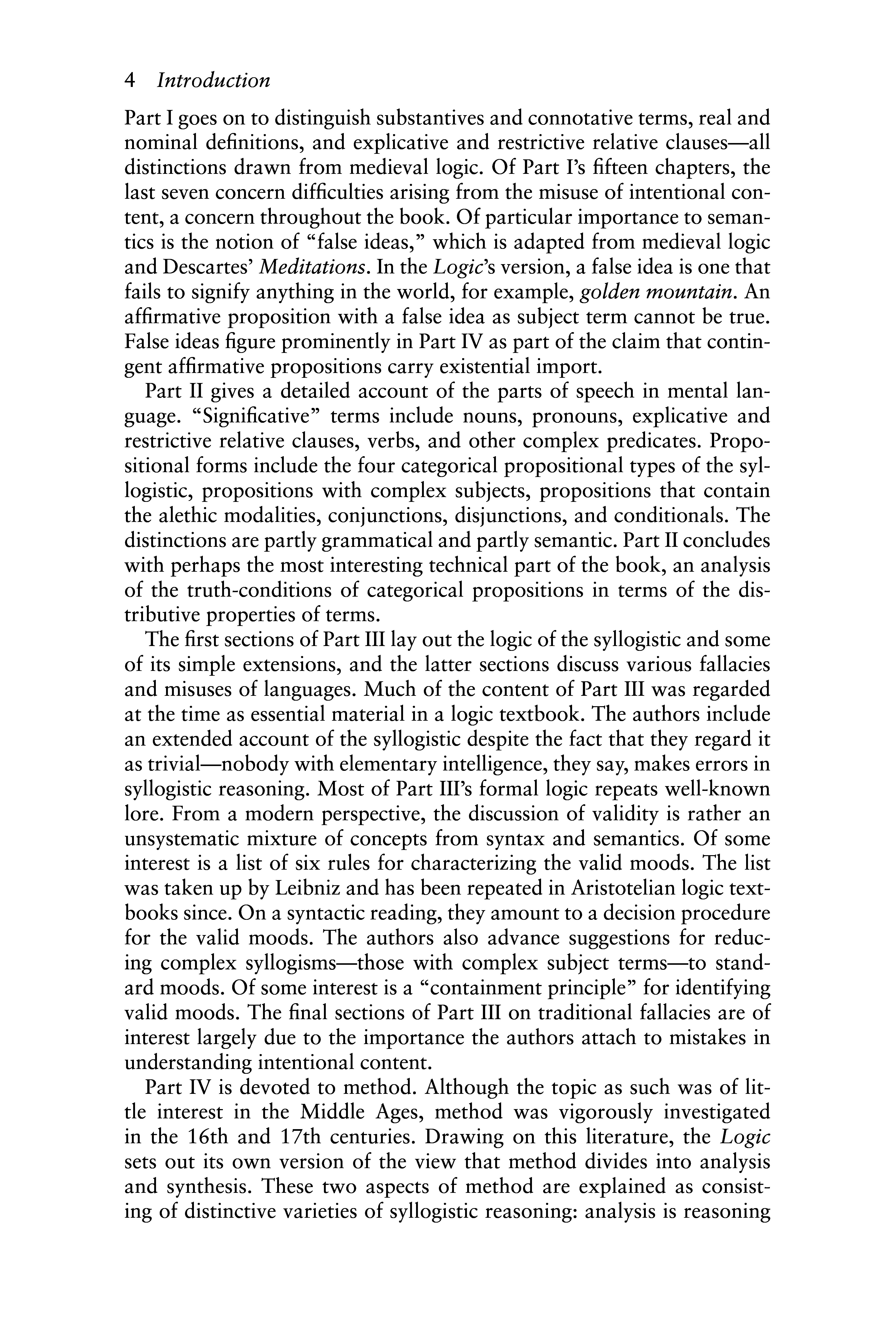
Part I goes on to distinguish substantives and connotative terms, real and nominal definitions, and explicative and restrictive relative clauses-all distinctions drawn from medieval logic. Of Part I's fifteen chapters, the last seven concern difficulties arising from the misuse of intentional content, a concern throughout the book. Of particular importance to semantics is the notion of "false ideas," which is adapted from medieval logic and Descartes' Meditations. In the Logic's version, a false idea is one that fails to signify anything in the world, for example, golden mountain. An affirmative proposition with a false idea as subject term cannot be true. False ideas figure prominently in Part IV as part of the claim that contingent affirmative propositions carry existential import.
Part II gives a detailed account of the parts of speech in mental language. "Significative" terms include nouns, pronouns, explicative and restrictive relative clauses, verbs, and other complex predicates. Propositional forms include the four categorical propositional types of the syllogistic, propositions with complex subjects, propositions that contain the alethic modalities, conjunctions, disjunctions, and conditionals. The distinctions are partly grammatical and partly semantic. Part II concludes with perhaps the most interesting technical part of the book, an analysis of the truth-conditions of categorical propositions in terms of the distributive properties of terms.
The first sections of Part III layout the logic of the syllogistic and some of its simple extensions, and the latter sections discuss various fallacies and misuses of languages. Much of the content of Part III was regarded at the time as essential material in a logic textbook. The authors include an extended account of the syllogistic despite the fact that they regard it as trivial-nobody with elementary intelligence, they say, makes errors in syllogistic reasoning. Most of Part Ill's formal logic repeats well-known lore. From a modern perspective, the discussion of validity is rather an unsystematic mixture of concepts from syntax and semantics. Of some interest is a list of six rules for characterizing the valid moods. The list was taken up by Leibniz and has been repeated in Aristotelian logic textbooks since. On a syntactic reading, they amount to a decision procedure for the valid moods. The authors also advance suggestions for reducing complex syllogisms-those with complex subject terms-to standard moods. Of some interest is a "containment principle" for identifying valid moods. The final sections of Part IlIon traditional fallacies are of interest largely due to the importance the authors attach to mistakes in understanding intentional content.
Part IV is devoted to method. Although the topic as such was of little interest in the Middle Ages, method was vigorously investigated in the 16th and 17th centuries. Drawing on this literature, the Logic sets out its own version of the view that method divides into analysis and synthesis. These two aspects of method are explained as consisting of distinctive varieties of syllogistic reasoning: analysis is reasoning
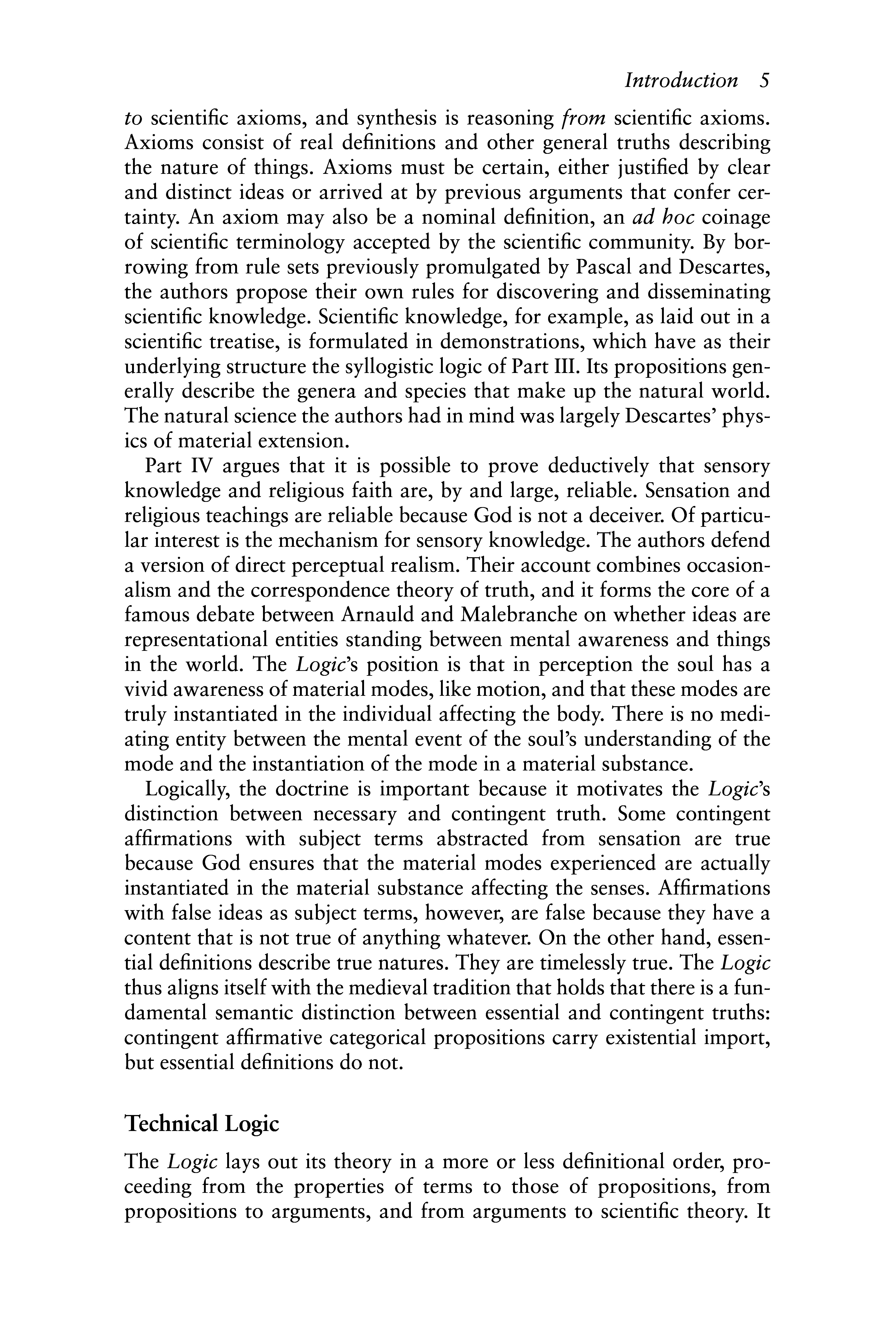
to scientific axioms, and synthesis is reasoning from scientific axioms. Axioms consist of real definitions and other general truths describing the nature of things. Axioms must be certain, either justified by clear and distinct ideas or arrived at by previous arguments that confer certainty. An axiom may also be a nominal definition, an ad hoc coinage of scientific terminology accepted by the scientific community. By borrowing from rule sets previously promulgated by Pascal and Descartes, the authors propose their own rules for discovering and disseminating scientific knowledge. Scientific knowledge, for example, as laid out in a scientific treatise, is formulated in demonstrations, which have as their underlying structure the syllogistic logic of Part III. Its propositions generally describe the genera and species that make up the natural world. The natural science the authors had in mind was largely Descartes' physics of material extension.
Part IV argues that it is possible to prove deductively that sensory knowledge and religious faith are, by and large, reliable. Sensation and religious teachings are reliable because God is not a deceiver. Of particular interest is the mechanism for sensory knowledge. The authors defend a version of direct perceptual realism. Their account combines occasionalism and the correspondence theory of truth, and it forms the core of a famous debate between Arnauld and Malebranche on whether ideas are representational entities standing between mental awareness and things in the world. The Logic's position is that in perception the soul has a vivid awareness of material modes, like motion, and that these modes are truly instantiated in the individual affecting the body. There is no mediating entity between the mental event of the soul's understanding of the mode and the instantiation of the mode in a material substance.
Logically, the doctrine is important because it motivates the Logic's distinction between necessary and contingent truth. Some contingent affirmations with subject terms abstracted from sensation are true because God ensures that the material modes experienced are actually instantiated in the material substance affecting the senses. Affirmations with false ideas as subject terms, however, are false because they have a content that is not true of anything whatever. On the other hand, essential definitions describe true natures. They are timelessly true. The Logic thus aligns itself with the medieval tradition that holds that there is a fundamental semantic distinction between essential and contingent truths: contingent affirmative categorical propositions carry existential import, but essential definitions do not.
Technical Logic
The Logic lays out its theory in a more or less definitional order, proceeding from the properties of terms to those of propositions, from propositions to arguments, and from arguments to scientific theory. It
would be anachronistic, however, to expect modern rigor. Concepts are sometimes introduced before their defining terms. Concepts are sometimes introduced by what appears to be a definition but which turns out be a description of only paradigm cases, and often concepts are explained by just a few examples. 2 What are called rules and axioms are often just important principles, not part of a formal axiom system in the modern sense. On the other hand, the metatheory has a clear conceptual development. The discussion in the following chapters will generally follow this conceptual order, necessitating some jumping forward and backward in the Logic's text. When a definition is missing or incomplete, an attempt will be made to give a formulation that captures the Logic's intent.
At times the Logic makes use of the technical jargon of its period. Frequently this has parallels in modern logic. When this happens, it is useful to translate the historical view into modern terms. Once translated, what is being said is often clearer to a modern reader. Because of their formal clarity, modern terms also make it easier to see a doctrine's implications. Formal reconstructions in modern terms, like those in the Appendix, also enable comparison to modern theory and evaluation according to mod. ern crIterIa.
At some points this sort of reformulation into modern terms is particularly useful. In Part I, for example, ideas emerge as having algebraic structure. Ideas, contents, and extensions form ordered sets, and these structures map into one another. Other commentators have remarked on similarities between the Logic and modern algebra, but as we shall see in Chapter 3, some of these are exaggerated. 3
In the enthusiasm for formal reconstruction there is a danger that a modern formulation may not be justified by the exact wording of the text or that the modern view attributes anachronistic implications, which follow because the modern vocabulary is embedded in a broad framework, like Boolean algebra or set theory. To avoid ungrounded reconstruction, the discussion throughout the book will keep close to the text, perhaps tediously so. Nevertheless, we shall find that the Logic does describe some structure that closely conforms to algebraic relations, and that these are fundamental to how ideas correspond to things in the world. These algebraic properties are the topic of Chapter 3 on the structure of ideas.
2 Arnauld admits as much, Arnauld and Nicole 1993, p. 335, B 260: this Logic was augmented almost by half since the first essays, which were written in four or five days, no one should be surprised if the different passages added at different times, and even while it was being printed, are not always as well placed as they might have been if they had been inserted from the start.
3 See Martin Martin Martin Martin Martin 2017, and the discussion at various points in this book.
Perhaps the most technically interesting part of the Logic is its statement of the truth-conditions for categorical propositions at the end of Part II. The issue there is whether a term's "distributive" extension can be used in a non-circular way to define the truth-conditions of categorical propositions. Because the related notion of distributive supposition in medieval logic was defined in terms of truth, it could not have been used without circularity to define truth itself. But by analyzing distribution directly through a term's referential properties, the Logic liberates distribution from its definitional dependence on truth, thereby enabling a definition of truth in terms of distribution. The account is the subject of Chapter 4.
The Logic's formal logic, which is set out in Part III, is limited to the syllogism and some of its simple extensions. Little of the material is technically new. An exception is the claim that syllogistic entailment is really a species of idea -containment. The claim is similar to the view sometimes advanced that Aristotle's syllogistic is founded on the so-called principle de omni et nullo. Chapter 4 explains how the Logic's version is correct when formulated in terms of the monotonic properties of the categorical quantifiers as explained in general quantification theory.
Part IV discusses analysis and synthesis. The account is technical in that it makes subtle use of syllogistic logic. Chapter 5 explains the details. Of some interest is the seemingly paradoxical claims that in "analysis" a theorem can be used to prove its premises, and that it is possible to deduce from a description of a particular event a general law that explains it.
The Appendix provides formal definitions of technical terms introduced informally in the book, as well as, several formal reconstructions of parts of the Logic's theory and a primer on syllogistic logic for those unfamiliar with it.
References
Arnauld, Antoine. 1990. On True and False Ideas, Manchester, Manchester University Press.
Arnauld, Antoine. 2003. (Euvres Philosophiques d!lArnauld, Bristol, Theommes Press. Kremer, Elmar and Denis Moreau (eds.).
Arnauld, Antoine and Pierre Nicole. 1993. La Logique ou d!lArt de Penser, Paris, Librairie Philosophique J. Vrin. Clair, Pierre and Girbal (eds.).
Arnauld, Antoine and Pierre Nicole. 1996. Logic or the Art of Thinking, Cambridge, Cambridge University Press. Buroker, Jill Vance (translator).
Auroux, Sylvain. 1993. La Logique des Idees, Montreal, Paris, Bellarmin, Vrin. Descartes, Rene. 1897-1909. (Euvres de Descartes, Paris, Vrin. Adam, C. and P. Tannery (eds.).
Kennedy, Rick. (ed.). 1995. Aristotelian & Cartesian Logic at Harvard, Boston, Colonial Society of Massachusetts (distributed by University of Virginia).
Martin, John N. 2011. Existential Import in Cartesian Semantics. History and Philosophy of Logic, 32:2, 1-29.
Martin, John N. 2013. Distributive Terms, Truth, and the Port Royal Logic. History and Philosophy of Logic, 133-154.
Martin, John N. 2016a. A Note on "Distributive Terms, Truth, and the Port Royal Logic." History and Philosophy of Logic, 37:4, 391-392.
Martin, John N. 2016b. Privative Negation in the Port Royal Logic. Review of Symbolic Logic, 9, 23.
Martin, John N. 2016c. The Structure of Ideas in the Port Royal Logic. The Journal of Applied Logic, 19, 1-19.
Martin, John N. 2017. Extension in the Port Royal Logic. South American Journal of Logic, 3, 1-20.
1 The Semantics of Terms. Intentional Content
A Cartesian Challenge
Arnauld and Nicole inherited and sustained an immense logical tradition. As followers of Descartes, they rejected some of Aristotle's views, but with respect to much of earlier logic they were conservative. Although they de-emphasis scholastic material like the syllogistic and placed new emphasize on others like intentional content, they endorsed unchanged large parts of medieval logic. A major exception was the theory of reference or, as they called it, signification. Signification lay at the heat of the earlier logical tradition because it entered into the definition of many other ideas. The standard explanation of signification, however, which held that bodily modes travels to the soul, was undermined by dualism. The reconstruction of signification is set out in Part I of the Logic. This chapter describes how the account is built up out of two parts: standard distinctions from traditional logic plus a reworked concept of intentional content based on the medieval notion of objective being.
Cartesian Ontology
At several points the Logic's the authors refuse to engage in metaphysics, which they regarded as a fruitless endeavor. They set aside as useless the problem of universals-the issue of whether universals exist, as they put it, a parte rei. 1 They also dismiss as "inconceivable" various Aristotelian concepts like substantial form, weight, and attractive powers.2 Instead, they endorse Descartes' dualism and his quasi-geometric physics of extended matter. But their remarks that distance themselves from Aristotle are misleading. Their rebellion was selectively. Key to their distinctive views is a long list of Aristotelian concepts that had become orthodox in medieval logic.
1 LAP, Discours I, KM V 112-113, B 11-12.
2 LAP IV.6, KM V 380-381, B 249.
Intentional Content
Perhaps their most fundamental Aristotelian commitment is to a substance-mode ontology. Part I endorses a long list of Aristotelian concepts that detail this ontology, which may be summarized here. The authors begin by partitioning Being into its two broadest species: substances and modes. This partitions is subdivided in the traditional way into Aristotle's ten categories: substance and nine species of modes: quality, quantity, relation, activity, passivity, place, time, position, and state. 3 Modes are also called attributes and qualities. The distinction between substances and modes is explained in the orthodox way. Substances have independent existence, but modes exist only as instantiated in substances. Modes are cross-classified into Porphyry's five predicables: genus, species, difference, property (proprium), and accident. 4 Predicables are distinguished from one another by the degree to which a mode is instantiated necessarily. Every species and genus has a necessary nature, whereas properties are necessary but not definitive, and accidents are contingent.
A species' nature or essence is described in a real definition, which is a necessarily true proposition that affirms of the species its genus and difference. As a result of their natures, species fall into a finitely branching finite tree-hierarchy that is headed by the highest genus, Being. Scientific knowledge consists primarily of essential definitions and their consequences. 5 All of these are thoroughly orthodox Aristotelian views. We shall see, however, that the authors give them a distinctive Cartesian cast.
The Logic's main departure from Aristotelian ontology is its dualism. The category of substance, it claims, is partitioned into "mind and body. " These "are the two species of substance."6 Although most medieval logicians would concur that there exists a fundamental difference between spiritual and material substance, what is distinctive in the Logic is the additional principle that the two species of substance cannot share modes. Modes that inhere in minds cannot inhere in bodies, and material modes cannot inhere in spirits. Although the principle has a ring of plausibility given dualism-indeed one wonders why ancient ontologists were not more troubled about spirits and minds sharing properties-it has devastating implications for the foundations of medieval metalogic. The inability of material modes to affect the mind vitiates what was then the standard account of signification, and along with signification other parts of the theory which were defied in terms of signification, for example, the definitions of truth and validity.
3 LAP 1.3, KM V 137-138, B 33-34. The authors describe the distinctions among the nice varieties of modes as "fairly useless." With the exception of relations, they seldom refer to them.
4 LAP 1.7, KM V 146-150, B 40-44.
5 LAP 1.6, 7, and 12.
6 LAP 1.6, KM V 148, B 42.
The standard theory had turned on the premise that material modes travel to the soul. As logic developed in the 13th century, it became accepted that, in the first instance, language is mental. Ontologically, language was believed to consist of accidental modes of the soul or "mental acts." These were thought to have a structure or grammar. Basic mental acts, which were called concepts, were understood to be signs for things in the world, or to be "significative." They could represent any category of being, whether material and spiritual. Concepts in turn were parts of, or causal preliminaries to, more complex acts called propositions. Propositions took various grammatical forms. Of these the four categorical propositions of the syllogistic were basic. Concepts served as their terms. A proposition was true or false depending on whether the world was "as its terms signified." A series of ordered propositions, in turn, formed a yet more complex structure called an arguments. An argument was valid or invalid depending on whether its inference preserved truth. There was an immense logical lore spelling out the details. It was not the purpose of the Port Royal Logic to overthrow this body of theory. The Logic is more accurately described as reworking elementary parts of medieval logic in a way that made it consistent with Descartes' philosophy. Providing a new analysis of signification was a major challenge.
Medieval Theories of Signification
Theories varied, but Aquinas' account of signification is representative. As a true Aristotelian, Aquinas understood concept formation to be empirical: "there is nothing in the intellect that was not first in the senses. "7 He conceived sensation to start with a physical process in which sensible properties, called a "sensible species," are conveyed through a sensible medium, like air and the sense organs, to be ultimately instantiated in the brain. Once the properties leave the body, they were thought to have a special ontological property: they did not affect-they were not "true of "-the medium in which they were instantiated. When a rose is seen, its redness travels through the air to the eyes without making either the air or the eyes red. A property in this state was said to be "intentional" in the sense that although it is instantiated in a subject, it is not true of the subject. The property is then conveyed from the body to the soul by the passive faculty of imagination, through which the soul experiences what Aquinas called a "phantasm," a state of awareness of
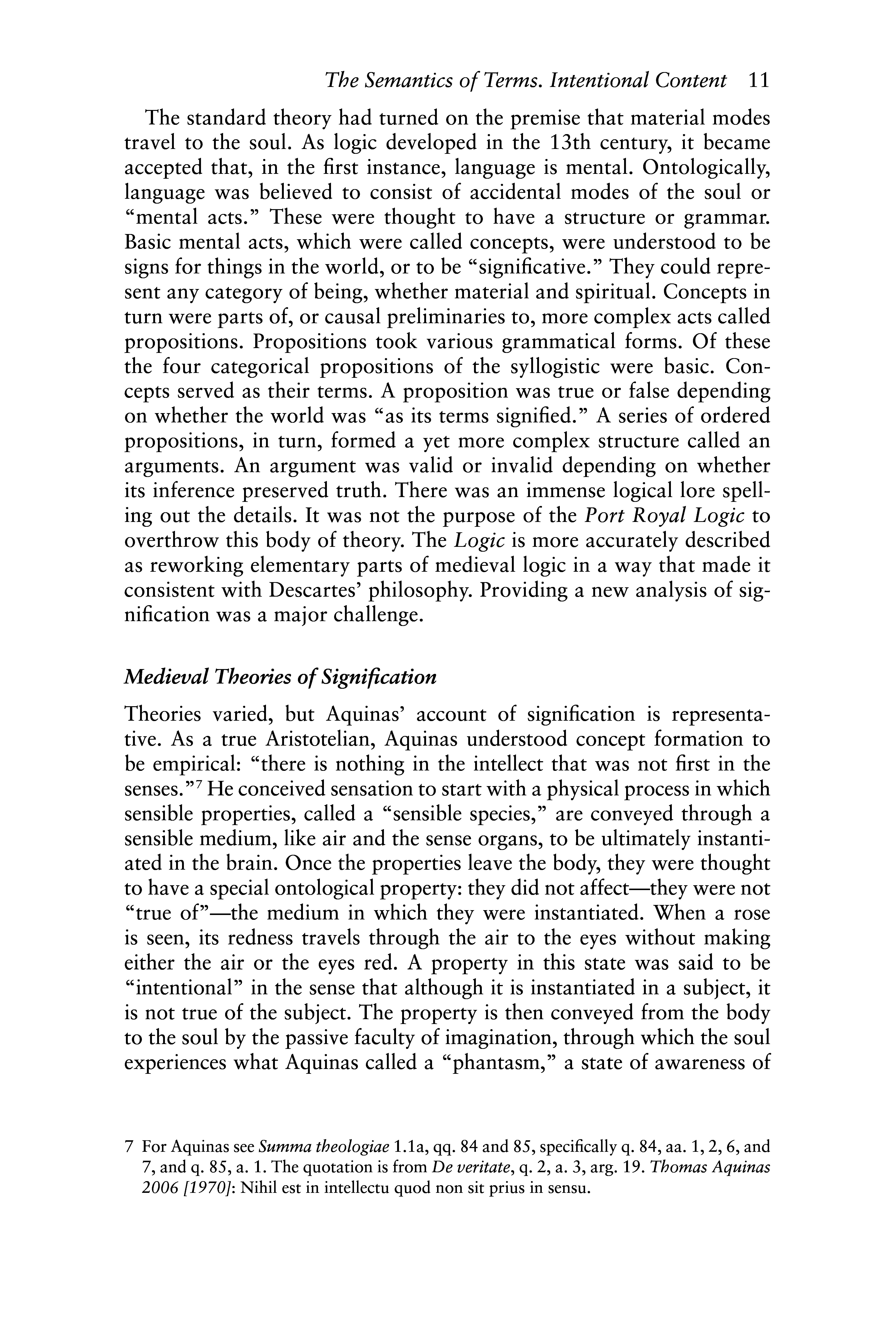
7 For Aquinas see Summa theologiae 1.la, qq. 84 and 85, specifically q. 84, aa. 1,2, 6, and 7, and q. 85, a. 1. The quotation is from De veritate, q. 2, a. 3, argo 19. Thomas Aquinas 2006 [1970]: Nihil est in intellectu quod non sit prius in sensu.
the properties of the individual being sensed. This set of properties was called the perceived individual's "sensible species." In Aquinas' view the very properties previously instantiated in the body outside the mind were instantiated in the soul but in what he called an "immaterial" and "immobile" way. It is this transfer of properties from the body to the soul that Arnauld and Nicole rejected. For dualists, a material property cannot be instantiated in the soul even "intentionally."
According to Aquinas, imagination is an intermediate stage of concept formation. Imagination is followed by "abstraction." From the panoply of the individual's particular properties experienced as part of the phantasm, the active intellect separates out one or more properties. The selected properties are then instantiated as a unit separately in the soul, again in an intentional manner. The actualization of this separate property instantiation is a mental act called a "concept," the ancestor of what the Cartesians would later call an idea.
Aquinas' causal process requires both the phantasm, as a "material cause," and the agent intellect, called an "active cause" because it acts upon the material cause to form a concept. Aquinas also holds, somewhat mysteriously, that the intellect may abstract from the sensible species the properties that constitute object's essential nature-its "quiddity" or "intelligible species"-which he says is generally non-sensible or "invisible." 8
The doctrine of sensation and abstraction is directly relevant to medieval semantics because the process is supposed to explain why concepts are "significative." The concept, which is a property instantiated in the soul, is the same property that was that was formerly instantiated in an individual outside the mind. The property in the soul, albeit instantiated intentionally, is supposed to be numerically identical to the property instantiated in object outside the mind. Nominalists, who denied that numerically the same property can be instantiated in more than one individual, would say that the property-instance in the soul is "similar" to the instance in the individual. In either case, the property in the soul, the so-called concept, possesses signification in two ways: descriptively and causally. Descriptively, it signifies all individuals that possess that property or, if you are a nominalist, it signifies all individuals that instantiate similar property-instances. Causally, it signifies all individuals that could have caused a phantasm from which the property concept could have been abstracted. In the passage below Aquinas refers to both the descriptive and causal properties of the concept, and
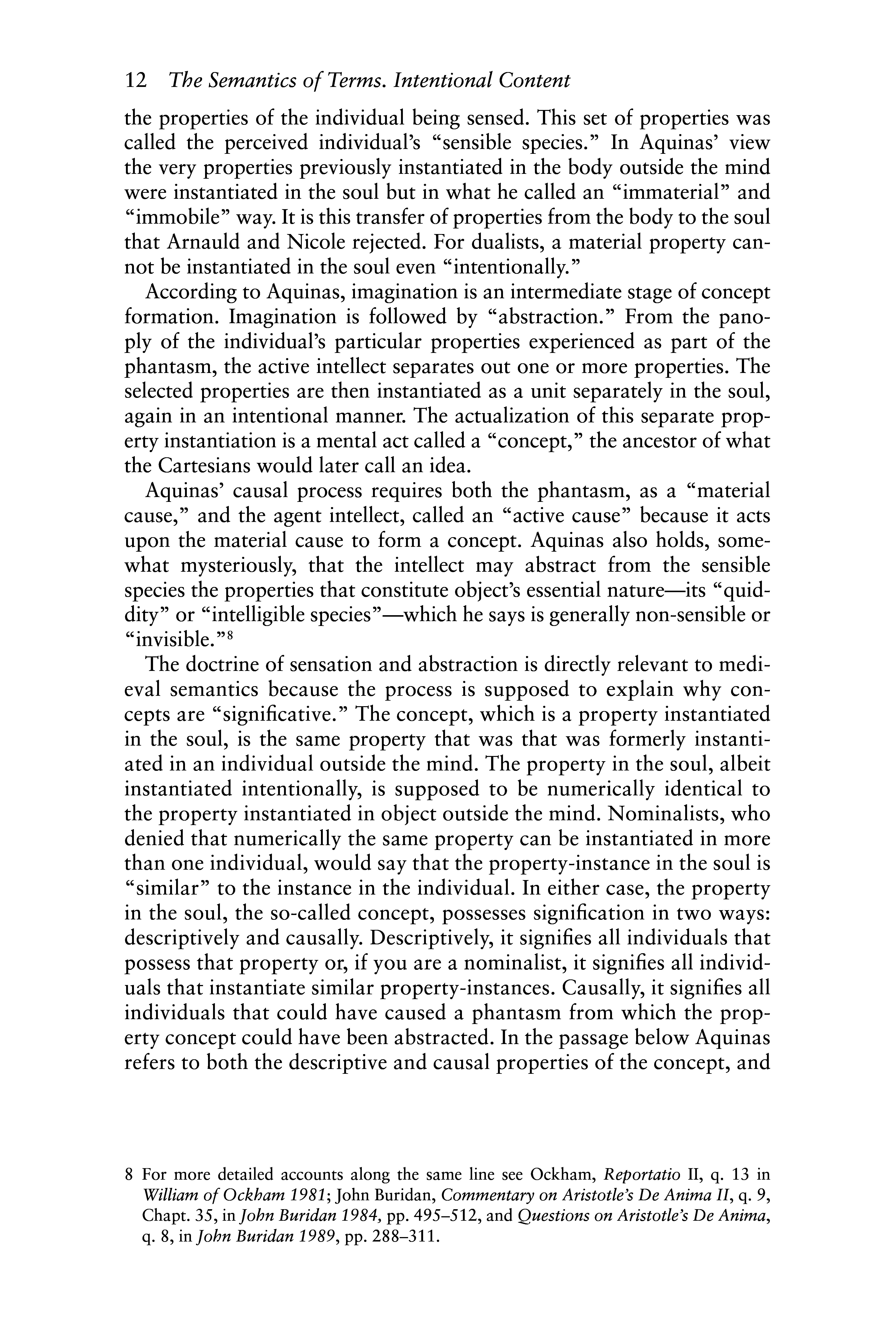
8 For more detailed accounts along the same line see Ockham, Reportatio II, q. 13 in William of Ockham 1981; John Buridan, Commentary on Aristotle's De Anima II, q. 9, Chapt. 35, in John Buridan pp. 495-512, and Questions on Aristotle's De Anima, q. 8, in John Buridan 1989, pp. 288-311.
speaks of the relation of the concept to its cause as one of similarity (aedequatio }:9
Moreover all cognition is accomplished by the assimilation [assimilation] of the cognizing thing to the thing cognized, so that assimilation is called the cause of cognition: as vision knows color through by being ordered by the species of color. Therefore the primary way in which being compares to the intellect is that being agrees with the intellect, which agreement indeed is called equality [aedequatio] of the intellect and the thing, according to which conformity, as it is said, cognition follows the thing. So therefore the being of a thing precedes the conceptualization [ratio] of truth, but cognition is a certain sort of veridical effect [quidam veritatis effectus].
Some like Olivi, Suarez, and Malebranche later reject the causal transfer of properties from matter to the soul because they subscribe to an Augustinian view that the direction of causation is the other way around, from spirit to matter. Nevertheless, they retain the descriptive part of the doctrine holding that concepts were properties of the soul similar to those of their significata. 1o
9 De veritate, Thomas Aquinas 2006 [1970J [51577] q. 1, a. 1, argo 7:
Convenientiam vero entis ad intellectum exprimit hoc nomen verum. Omnis autem cognitio perficitur per assimilationem cognoscentis ad rem cognitam, ita quod assimilatio dicta est causa cognitionis: sicut visus per hoc quod disponitur secundum speciem coloris, cognoscit colorem. Prima ergo comparatio entis ad intellectum est ut ens intellectui concordet: quae quidem concordia adaequatio intellectus et rei dicitur; et in hoc formaliter ratio veri perficitur. Hoc est ergo quod addit verum super ens, scilicet conformitatem, sive adaequationem rei et intellectus; ad quam conformitatem, ut dictum est, sequitur cognitio rei. Sic ergo entitas rei praecedit rationem veritatis, sed cognitio est quidam veritatis effectus. Secundum hoc ergo veritas sive verum tripliciter invenitur diffiniri. Uno modo secundum illud quod praecedit rationem veritatis, et in quo verum fundatur; et sic Augustinus definit in Lib. Soli!.: verum est id quod est; et Avicenna in sua Metaphysic.: veritas cuiusque rei est proprietas sui esse quod stabilitum est ei; et quid am sic: verum est indivisio esse, et quod est. Alio modo definitur secundum id in quo formaliter ratio veri perficitur; et sic dicit Isaac quod veritas est adaequatio rei et intellectus; et Anselmus in Lib. de veritate: veritas est rectitudo sola mente perceptibilis. Rectitudo enim ista secundum adaequationem quamdam dicitur, et philosophus dicit in IV Metaphysic., quod definientes verum dicimus cum dicitur esse quod est, aut non esse quod non est. Tertio modo definitur verum, secundum effectum consequentem; et sic dicit Hilarius, quod verum est declarativum et manifestativum esse; et Augustinus in Lib. de vera Relig.: veritas est qua ostenditur id quod est; et in eodem libro: veritas est secundum quam de inferioribus iudicamus.
10 On Olivi see John Buridan 1989, qq. 72 and 73. On Buridan see John Buridan 1989, Appendices Cl and C2, pp. 485-621. On Suarez see De Anima IV in Suarez 18561878, 2.17, p. 721; 8.13, p. 745; 2.13, p. 719; 4.1, p. 731; 2.12-13, pp. 719-720, as well as pp. 740 and 528. On Malebranche see the discussion in Chapter 5 below. For a general discussion of these issues see Tachau 1988 and Pasnau 1997.
Intentional Content
Arnauld and Nicole cannot accept any of these accounts because, in their view, ideas, which are modes of the soul, are not in any sense, not even "intentionally," be modes of bodies. Material modes cannot be transmitted to the soul through sensation. They explain: 11
It is thus false that all our ideas originate in the senses. On the contrary, one can say that no idea in the mind originates in the senses, although motions in the brain, which is all the senses can bring about, may provide the occasion for the soul to form various ideas that might not have been formed without this occasion. Indeed, even these ideas almost never resemble what is in the senses and the brain. Furthermore, it would be absurd to attribute the many ideas that have nothing whatever to do with corporeal images to the senses.
The authors adopt instead a version of occasionalism. In their view, on the occasion in which a material substance affects the body's sense organs, God causes there to be in the soul a sensory perception. This perception is a mode of the soul. It has not been caused by any alterations of the body. There is no property transfer. It remains true on their view, however, that during the experience, the soul is vividly aware of modes. Some of these like extension, motion, and relative position are in fact the very same modes that are true of the material substance currently affecting the body's sense organs. Others, like color and taste, are true only of the soul, even though ordinary folk think they are true of material things outside the mind.
The authors, however, retain part of the medieval account. The modes that is experienced on the occasion of sensation, which Aquinas called the sensible species, provide the material for subsequent abstraction and the formation of abstract ideas. But at this point the authors face an explanatory problem. How can a perception, which is a mode of the mind, convey awareness of other modes like extension that are true of objects outside the mind? How is it, in other words, that a perception has a content that consist of modes distinct from those of the soul itself, some of which are material and some mental? The same problem carries over to ideas formed by abstraction. If an abstract idea is mode of the soul, how can it be an idea of something that possesses modes different from those of the soul and its modes? How can an idea have a "content"?
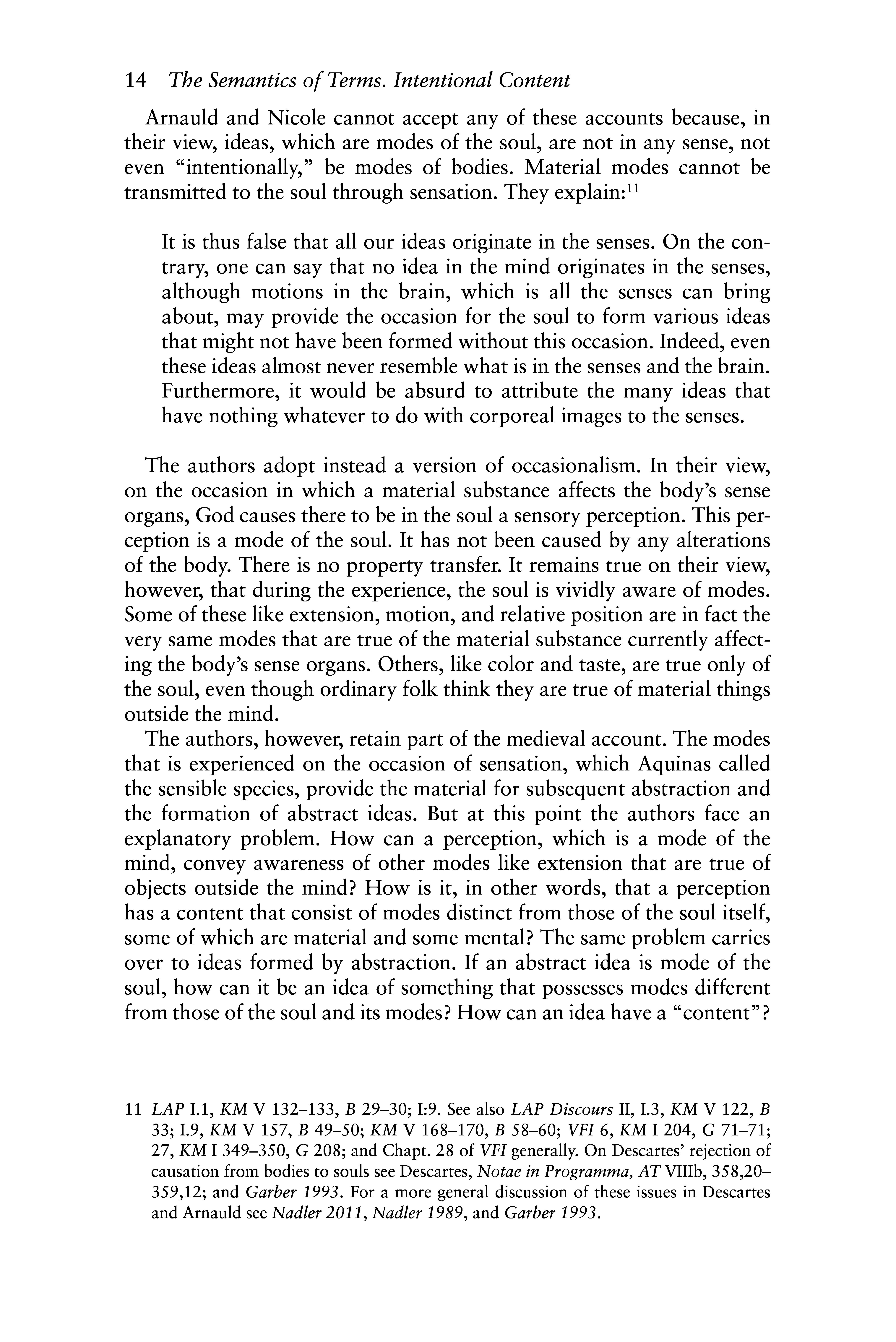
11 LAP 1.1, KM V 132-133, B 29-30; 1:9. See also LAP Discours II, 1.3, KM V 122, B 33; 1.9, KM V 157, B 49-50; KM V 168-170, B 58-60; VFI 6, KM I 204, G 71-71; 27, KM I 349-350, G 208; and Chapt. 28 of VFI generally. On Descartes' rejection of causation from bodies to souls see Descartes, Notae in AT Vlllb, 358,20359,12; and Garber 1993. For a more general discussion of these issues in Descartes and Arnauld see Nadler 2011, Nadler 1989, and Garber 1993.
An idea cannot literally be the same mode as one that occurs in its content, as it was in medieval descriptive theories. Nor is a causal account possible. The idea is not causally connected to what it stands for. How then does an idea signify? The Logic's theory of reference provides the answer to this question. At its center is a notion of intentional content. Explaining the solution requires a review the Logic's particular account of intentional content.
Contrary to what is sometimes said, intentionality in philosophy did not start with Brentano. It is a medieval concept and fundamental to the Logic's semantic. The particular sense the Logic employs derives from the medieval notion of objective being. Objective being is probably most familiar to modern students from its appearance in Descartes' Meditation III, but earlier versions had been used in explanations throughout the Middle Ages. The Logic's authors accepted some of its earlier properties and reject others, ending up fashioning a concept suited to their particular explanatory purposes. In earlier accounts objective being was a sui generis explanatory entity with an ontological status distinct from both spirit and matter. The version that emerges in the Logic, however, is one that is ontologically neutral but nevertheless suitable for its role in semantics. To understand the Logic's particular view of intentional content, it is necessary to review how it accepts some and rejects others of the medieval versions of the notion that preceded it. This review of the history of objective being leading to the Logic's particular version will be the first of several such explorations of the roots of key concepts in the Logic.
Objective Being as CWhat Is
The task before Arnauld and Nicole was to rebuild on Cartesians lines the foundations of signification theory. A causal account was closed due to dualism. On the other hand, a descriptive theory was possible. Their version turns on objective being. Objective being had occurred frequently enough in earlier logic that it merited short explanations in 16th- and 17th-century logic textbooks. The details of its earlier versions differed somewhat depending on the problem it had been introduced to explain. Common to all accounts was that objective being is an "object of understanding." Exactly what this meant depending on the kind of understanding in question. One kind understanding was that of an abstract concept or common noun. In this case objective being was identified with "what we understand" when we understand the term. Another kind of understanding was that associated with perceptual illusions. In this case objective being was identified with "what it is we sense" when we experience an illusion. Objective being was also said to explain God's understanding prior to creation. In this case objective being was identified with the "exemplar causes" God referred to in the act of creation or with the "essence" or real definition that he knew to be true of species prior to
16 The Semantics of Terms. Intentional Content
creation. Usually, objective being was understood to occupy a special ontological status distinct from spirit and matter. More importantly for the history of the Logic, in some later accounts objective being was identified with a second-order mode of a concept, as a mode of a mode in the soul.
Duns Scotus (1266-1308) provides one of the earliest examples of objective being as an explanatory entity. Scotus explains God's understanding of creatures prior to creation as relation that holds between God and an exemplar cause. This cause is described as "the thing as understood by him." A creature prior to its creation did not exist in reality, but God nevertheless understood it. What he understood at creation is the same as what he understands now and in the future. His understanding is eternal. The object of this understanding, "the thing understood," has a special kind of being, which he referred to as esse cognitum or esse diminutum. It is this entity that is the object both of divine and human knowledge when it is understood as part of an essential truth. Its special status explains why descriptions of essences are non-contingent and eternally true. Scotus explains the view as follows: 12
Therefore I say that a thing from eternity did not have a true essential or existential being, but grounded an ideal relation according to diminished being which it has from eternity (which is true being, distinct from essential and existential being, as is evident from Metaphysics IV): as if it were posited that I had existed from eternity and that from eternity I had understood a rose according to its essential and existential being [esse essentiae et esse exsistentiae]; and although it did not have anything but cognized being [esse cognitum],
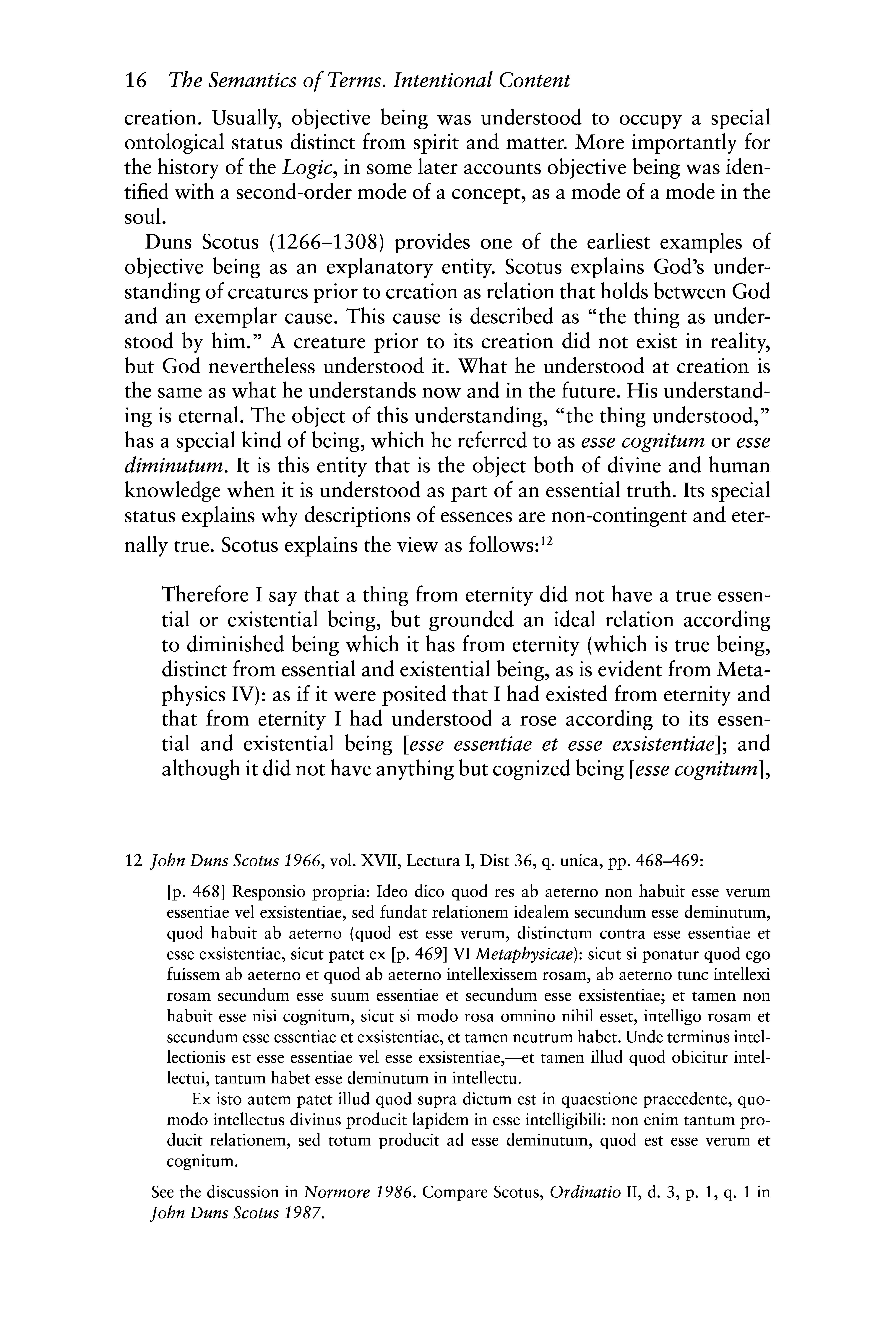
12 John Duns Scotus 1966, vol. XVII, Lectura I, Dist 36, q. unica, pp. 468-469: [po 468] Responsio propria: Ideo dico quod res ab aeterno non habuit esse verum essentiae vel exsistentiae, sed fundat relationem idealem secundum esse deminutum, quod habuit ab aeterno (quod est esse verum, distinctum contra esse essentiae et esse exsistentiae, sicut patet ex [po 469] VI Metaphysicae): sicut si ponatur quod ego fuissem ab aeterno et quod ab aeterno intellexissem rosam, ab aeterno tunc intellexi rosam secundum esse suum essentiae et secundum esse exsistentiae; et tamen non habuit esse nisi cognitum, sicut si modo rosa omnino nihil esset, intelligo rosam et secundum esse essentiae et exsistentiae, et tamen neutrum habet. Unde terminus intellectionis est esse essentiae vel esse exsistentiae,-et tamen illud quod obicitur intellectui, tantum habet esse deminutum in intellectu.
Ex isto autem patet illud quod supra dictum est in quaestione praecedente, quomodo intellectus divinus producit lapidem in esse intelligibili: non enim tantum producit relationem, sed totum producit ad esse deminutum, quod est esse verum et cognltum.
See the discussion in Normore 1986. Compare Scotus, Ordinatio II, d. 3, p. 1, q. 1 in John Duns Scotus 1987.
as if in a way the rose were entirely nothing, I understand the rose both according to essential and existential being, even though it has neither. While the terminus of intellection is essential or existential being, what is objectified in an intellection [quod obicitur intellectui] has only a diminished being [esse deminutum] in the intellect. From this moreover what was said in the preceding question above is evident, in whatever way the divine intellect produces a stone, it exists in intelligible being [intelligible being]: for it does not just produces a relation but produces a whole thing in diminished being [esse dimiutum], which is true and cognized being [esse verum et cognitum].
Scotus here refers to a feature of esses cognitum that later writers came to think of as a defining characteristic of objective being, but one that Arnauld and Nicole later reject. An objective being is a relatum distinct from God and things in the actual world. It is apart from the mind. As such, it seems to have a special ontological status distinct from matter and spirit. Arnauld and Nicole later rejected this view as postulating superfluous entities. As we shall see, objective being for them is spiritual; it is a property of ideas.
There is a second feature of Scotus' view only implicit in the text but drawn out by later writers. The object of knowledge is understood as possessing properties or, in Cartesian language, as possessing modes. Today we would say that objective being has a descriptive content. The descriptive aspect is key to various explanatory applications of objective being, and remains the core of Logic's later version.
Although William of Ockham later rejected objective being, in his earlier work he proposes a version that draws on its descriptive content. 13 As in Scotus' account, this entity is "the object of understanding." In Ockham's case it is the object of understanding an abstract idea. He calls it a "fiction" or (ictum. 14
the universal is not something real having subjective being, neither in the soul nor outside the soul, but only has objective being in the soul, and is a certain fiction [(ictum], having such being in objective being as an external thing has in subjective being. And this is so in the way that the intellect, seeing some thing outside the soul, fashions a consimilar thing in the mind, such that, if [the intellect] were to have productive power as it has fictive power, it would produce such a thing in subjective being outside [the soul] numerically distinct from
13 For his later rejection of (icta as unnecessary see Ouodlibet 4, q. 35 in William of Ockham 1991, vol. II, p. 387.
14 Ockham, Ordinatio 1, d. 2, q. 8 in William of Ockham 1987, pp. 3-4.
The Semantics of Terms. Intentional Content
the former [thing], and [that which is produced] would be proportionately similar [to that former thing], as it is for the architect.
Here Ockham says outright that a fictum has descriptive content. It is "consimilar" to what it represents. It exhibits the very modes possessed by the things it stands for. Moreover, he is clear about its ontological status. This entity is not a thing in the material world because it is abstract. Nor does it fall in the category of mode, spiritual or otherwise. For this claim he has an argument. The object of understandings, albeit abstract, may fall in any of Aristotle's ten categories. Therefore, it cannot simply be a mode, which would have to fall exclusively in the category of quality: "a fictum can be of any category [of being] but a mental mode is only a quality. Hence the two are different. "15
Ockham hypothesizes ficta to explain the object of abstract understanding. About the same time Peter Aureol (1275/80-1322) postulated objective being to explain illusions. According to Aureol when experiencing an illusion, we cannot be sensing a real being in the world outside the mind. He reasons that nevertheless we sense something. In some sense the object of an illusion exists. He says it exists "objectively":16
When one is carried on the water, the trees existing on the shore appear to move. This motion, therefore, which is objectively in the eye [in oculo objective] cannot be posited to be the [sense of] vision itself; otherwise vision would be the object seen, and vision would have been seen, and vision would be a reflective power. Nor can it be posited to be really in the trees or in the shore, because then they would really have moved. Nor can it be posited to be in the air because it is not attributed to the air but to the trees. Therefore, it is only intentionally [tantum intentionaliter], not really, in seen being and in judged being.
It is clear for Aureol that objective being has an ontological status distinct from the mind and the material world. Ex hypothesis, because it the object of an illusion, it does not exist in the actual world. Nor is it in the soul because the properties exhibited by the object of an illusions, for example, the movement of trees on the sea shore, are not in general properties of the soul. While the object of perception exhibit locomotion, the soul itself is not the sort of thing that "moves."
Although Ockham, the nominalist, ultimately rejected ficta as unnecessary, others embraced them. Franciscus Toletus (1532-1596), for
15 Ibid., p. 4.
16 Peter Aureol, Scriptum in I Sentarium, lat. 329, d. 3, s. 14, a. 1; 11:696, quoted in Brown 2007. See also Tachau 1988.
The Semantics of Terms. Intentional Content 19
example, expanded on Scotus' view that identified the object of abstract understanding with objective being. Toletus makes explicit that that objective being is distinct from both the intellect and its properties, on the one hand, and objects in the world, on the other. As evidence he cites what were then called "beings of reason." We can understand, he points out, a non-existent non-mental entity, like a chimera. These exist neither in the mind nor outside it: 17
[the] thing that the intellect understands is said to be in the intellect objectively. This is why the soul, which the intellect understands, is said to be objectively in the intellect, not because these things inhere but because they are understood through its operation. Accordingly, a thing that is outside the intellect, it is said to be objectively in the intellect when is it is understood. Therefore, of those that are objectively in the intellect some have being in themselves, apart from the being by which they are understood. For example, man, animal, and whiteness have both objective being in the intellect and being in themselves, since they are no less separate for being understood; some do not have being in themselves when understood, and these are said to have only objective being, like a Chimera.
Others, notably Francisco Suarez (1548-1617) and Nicolas Malebranche (1638-1715), go beyond Toletus to regard an objective being as a quasi-Platonic entity in the tradition of Augustine. They expand on Scotus' view that God stands in a relation to objective being. In their accounts not only does objective being fall in a special category of entity distinct from both the soul and the matter, it constitutes an eternal exemplar in God's mind, which God referred to as a model when he created the world. These had to exist in God's mind eternally because he always knew their essential properties. Not only do they explain God's knowledge of essences prior to creation, they also account for our own knowledge of essential truths. Suarez espoused a correspondence theory of truth, even for cases in which what is described does not exist in the world. An essential truth, like a species definition, is true
17 Prooemium, Quest. III, p. 15 in Toletus 1580: ali quid dicitur esse in intellectu objective, illud scilicet quod ab intellectu cognoscitur, quo pacto omnia, quae intellectus cognoscit, dicuntur, esse objective in intellectu, non quod ipsi inhaereant sed quod per ipsius operationem intelligantur. unde res, quae est extra intellectum, quando cognoscitur, dicitur esse objective in intellectu. Horum igitur, quae objective sunt in intellectu, quaedam habent esse in se, licet non eo modo, quo intelliguntur, ut homo, animal, albedo, habent esse objective in intellectu & in se, quamvis non sint separata, sicut intelliguntur; quaedam non habent aliud esse in se, quam cognosci, & ista dicuntur habere solum esse objective in intellectu: sicut Chimera.
